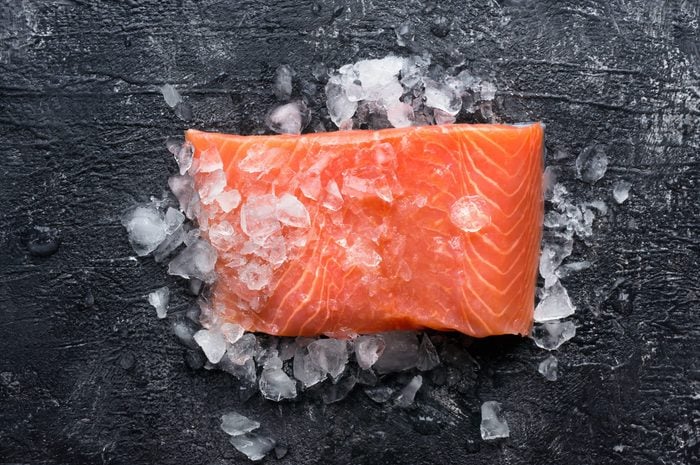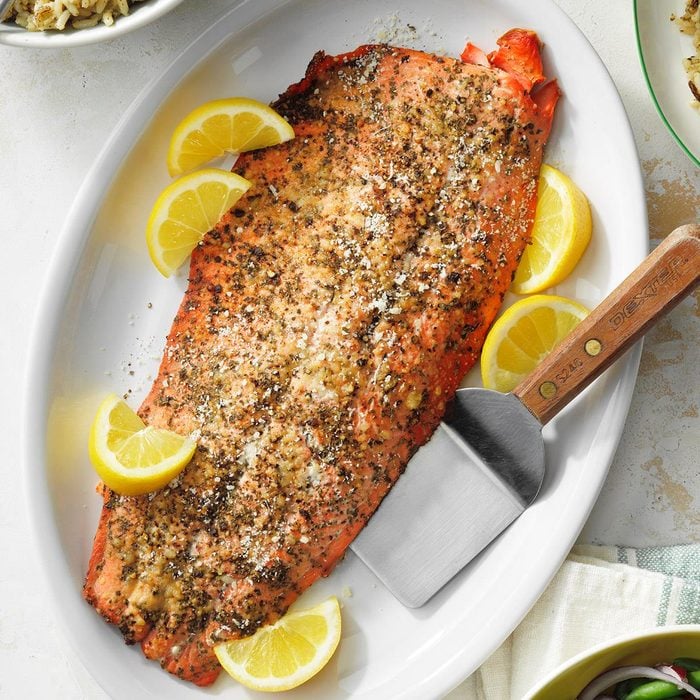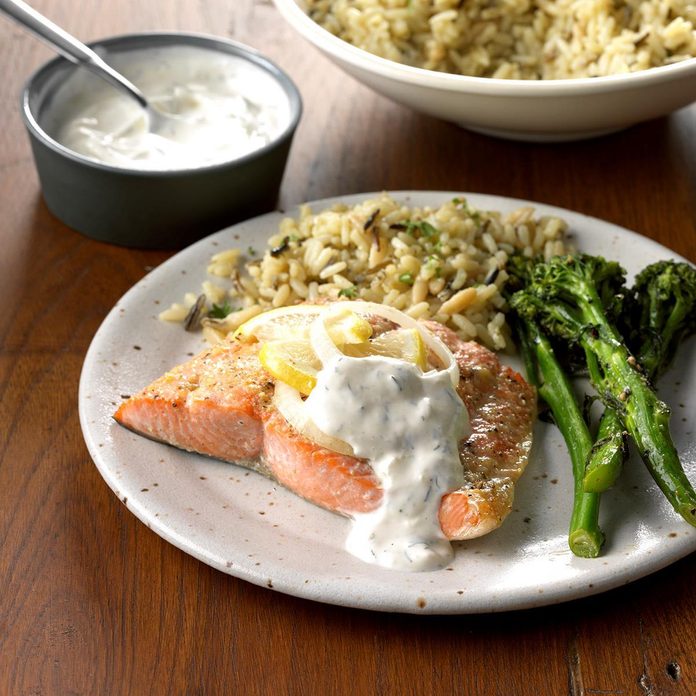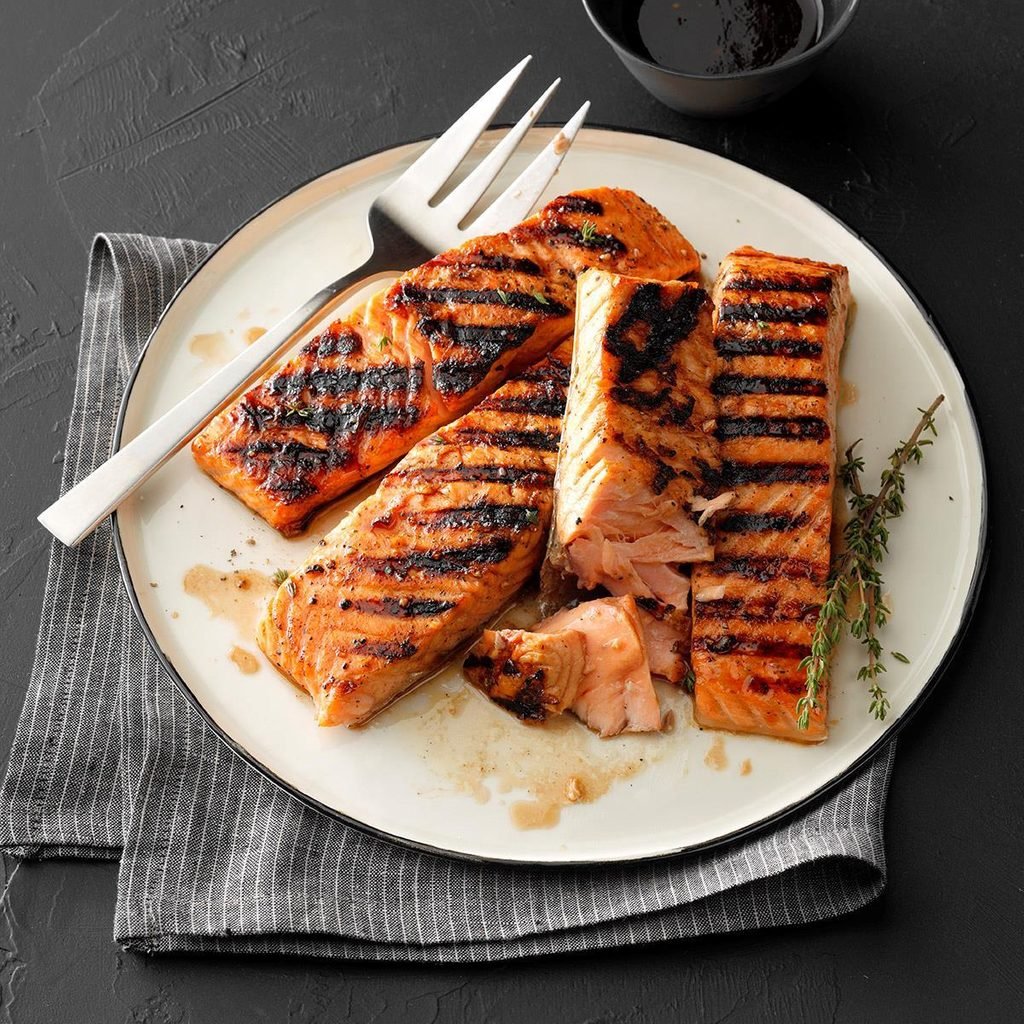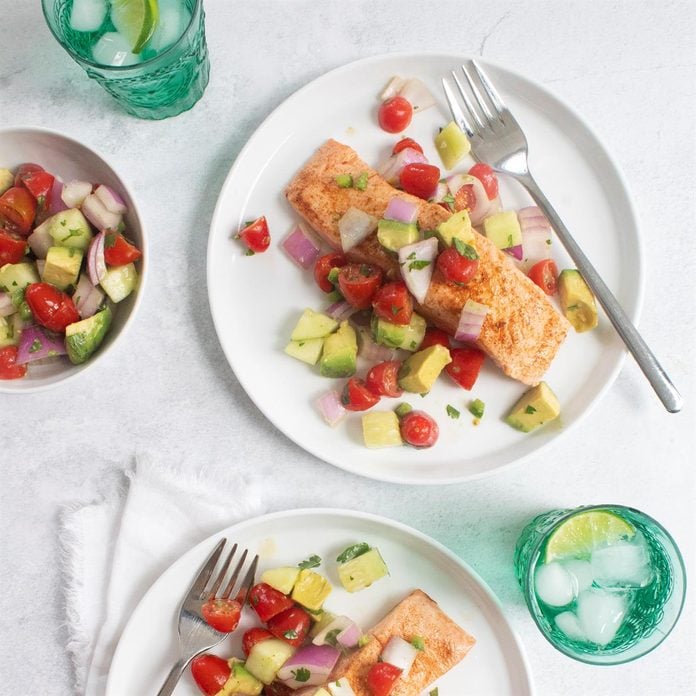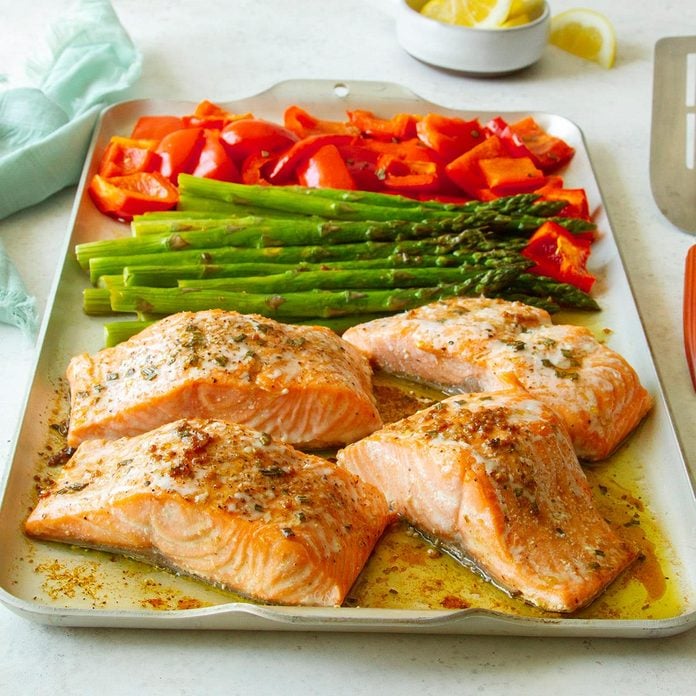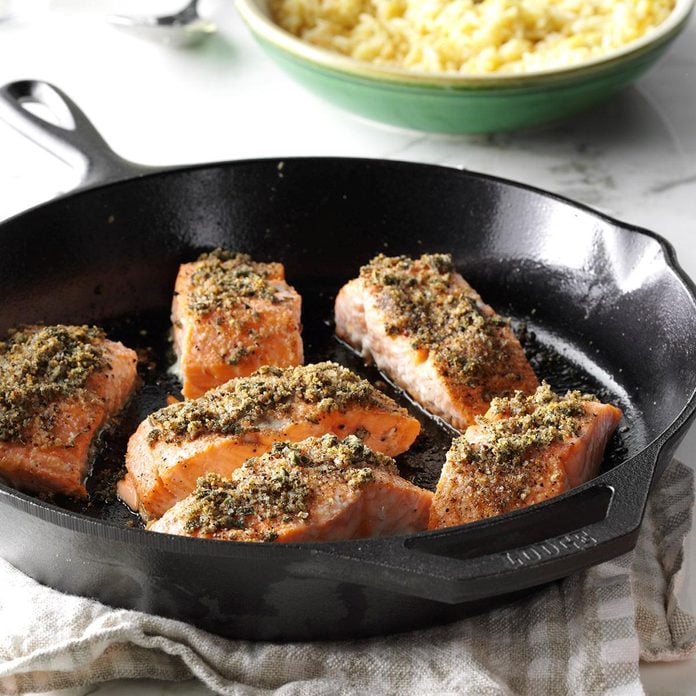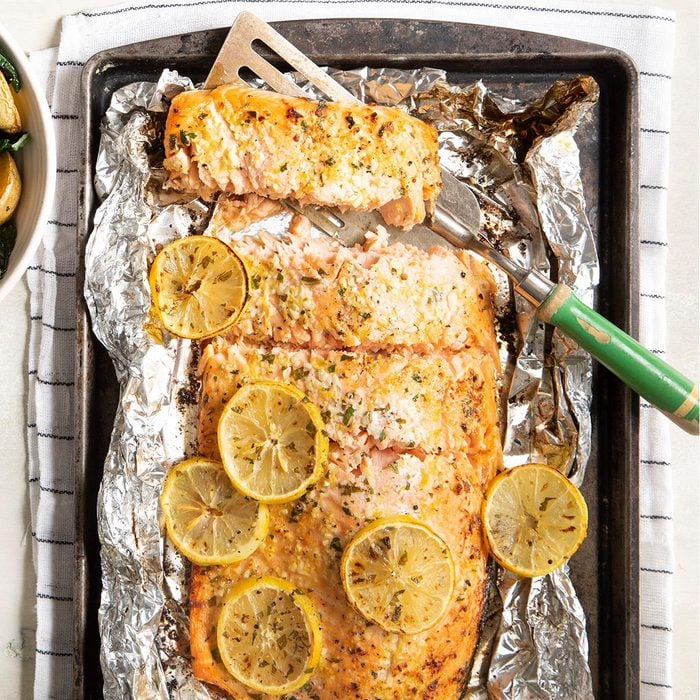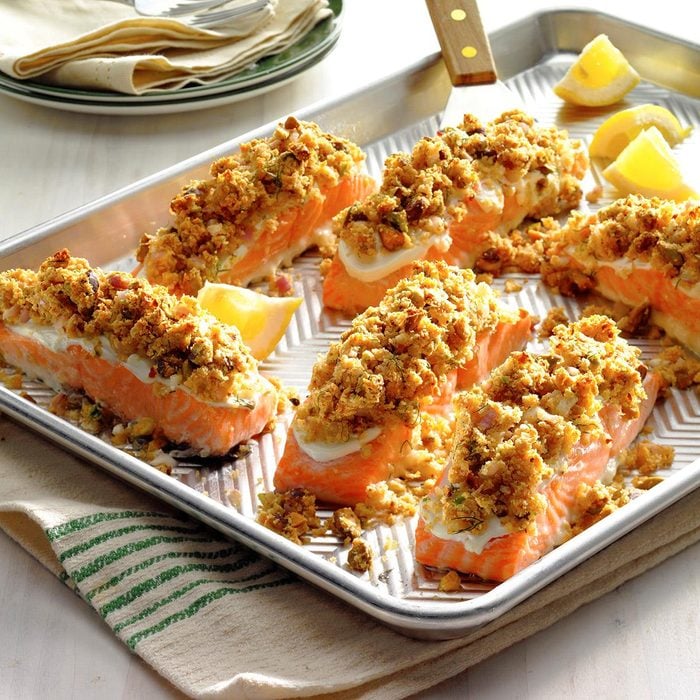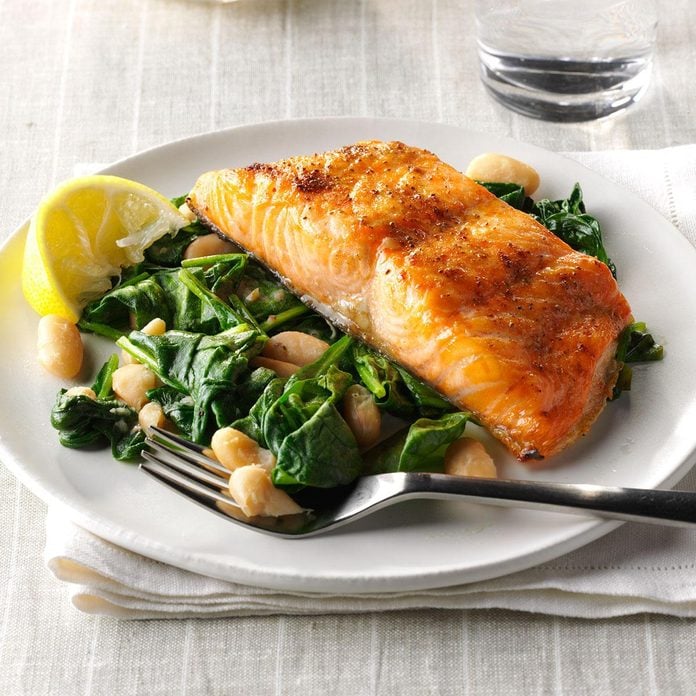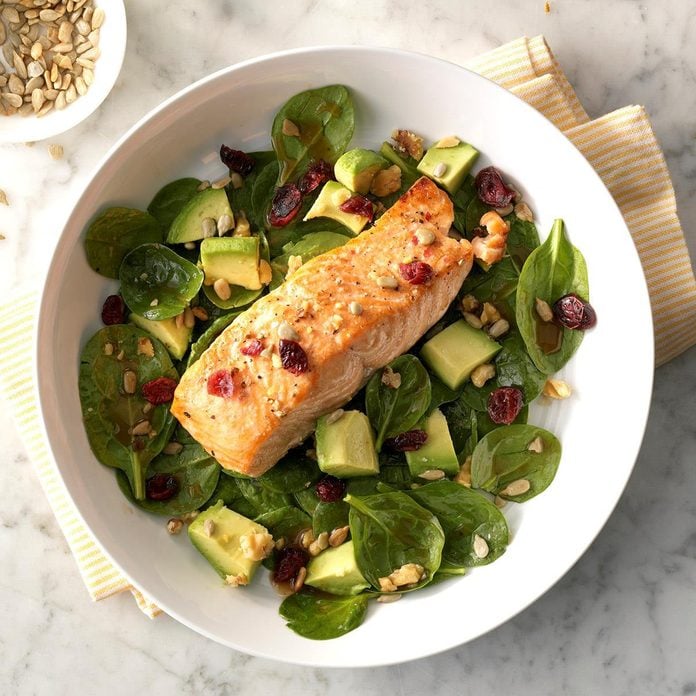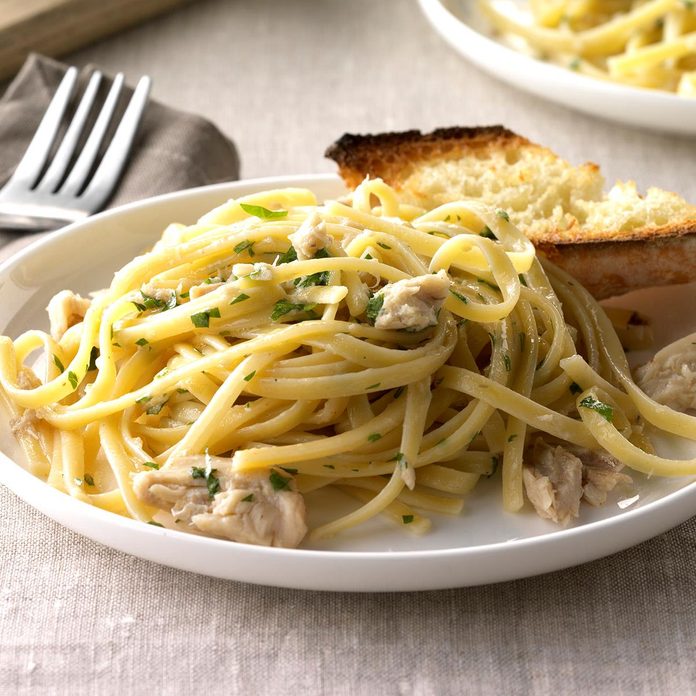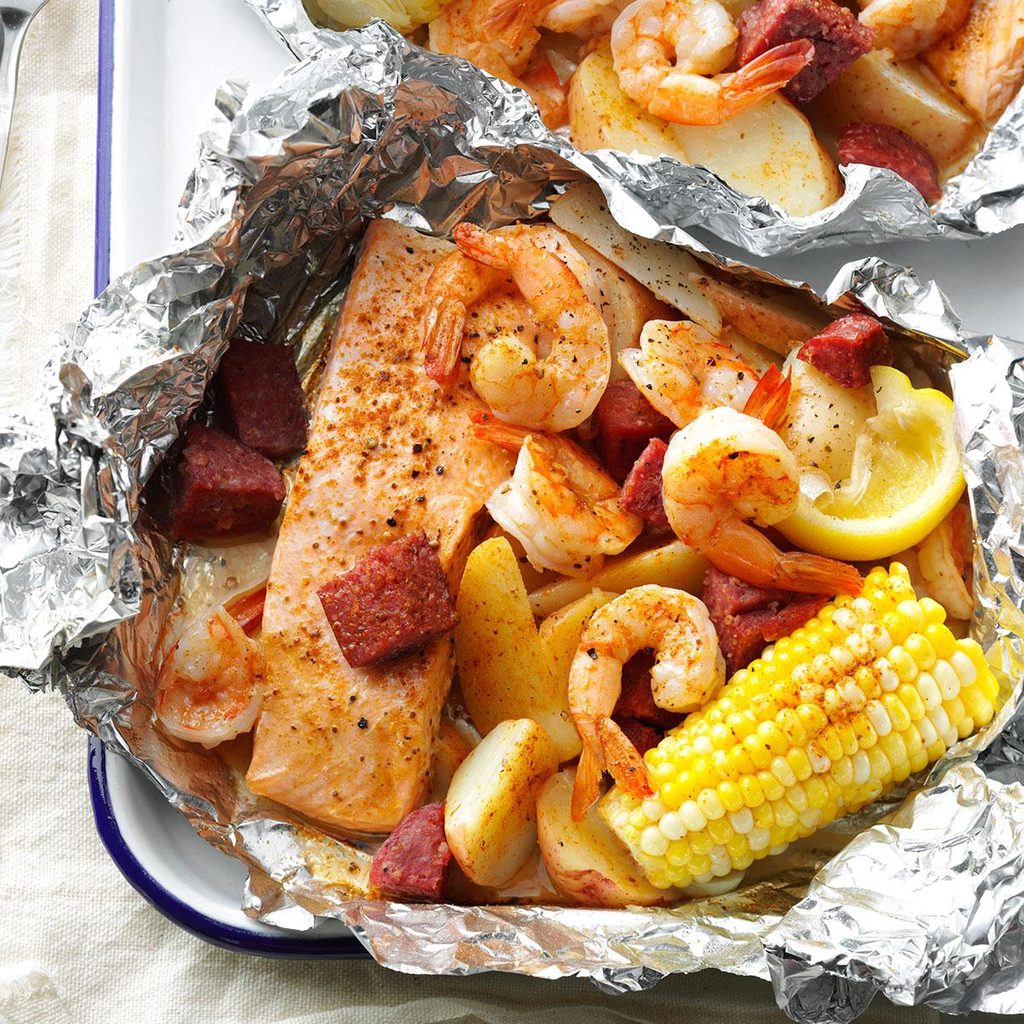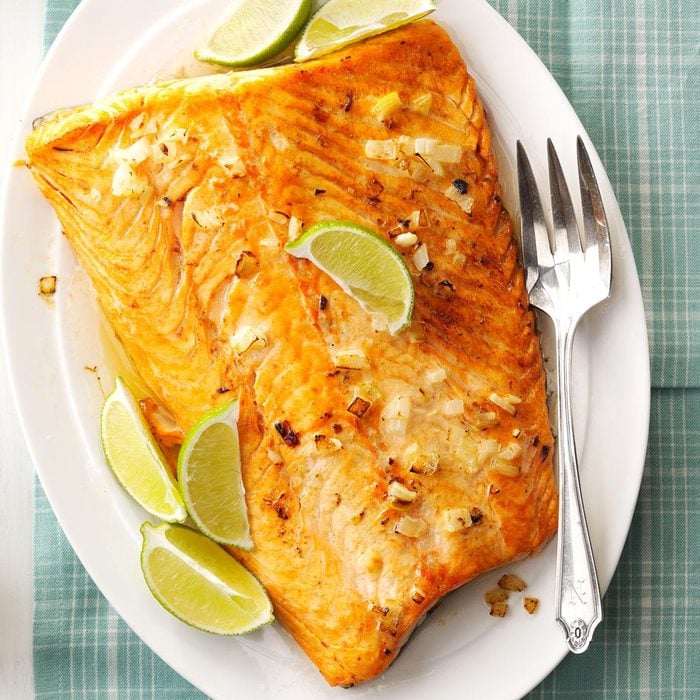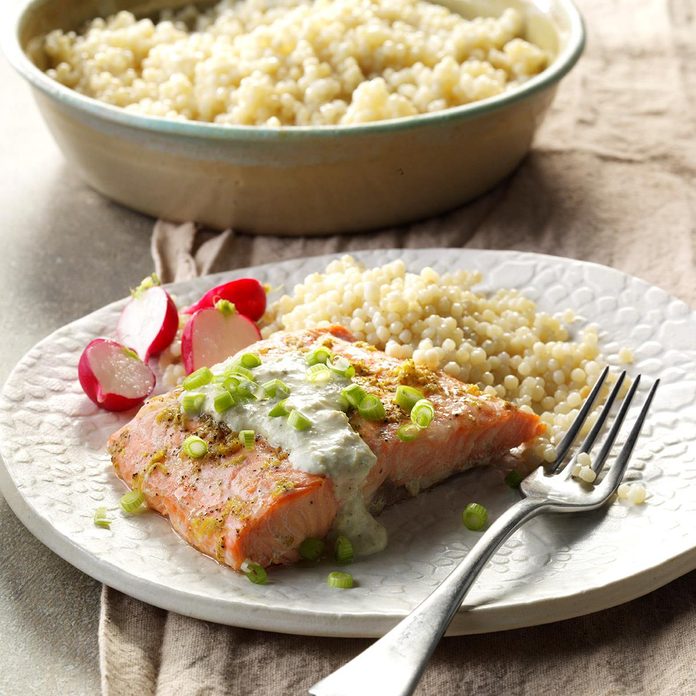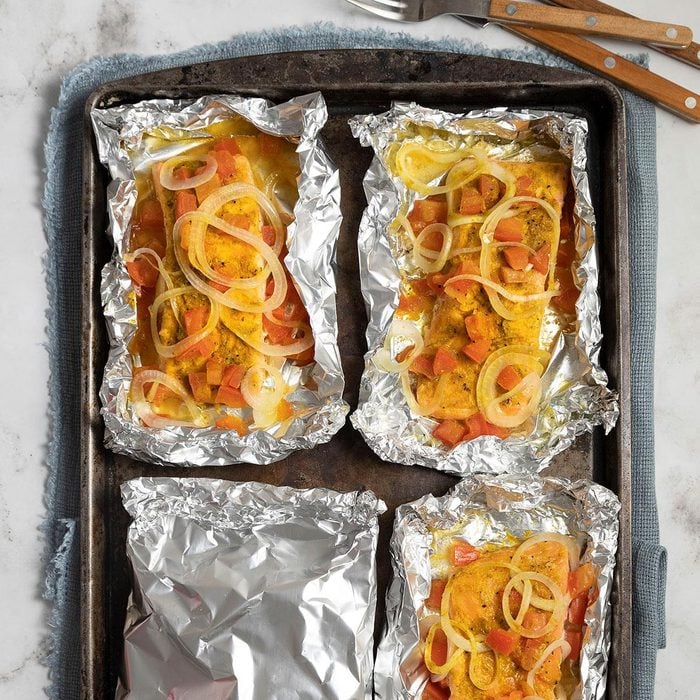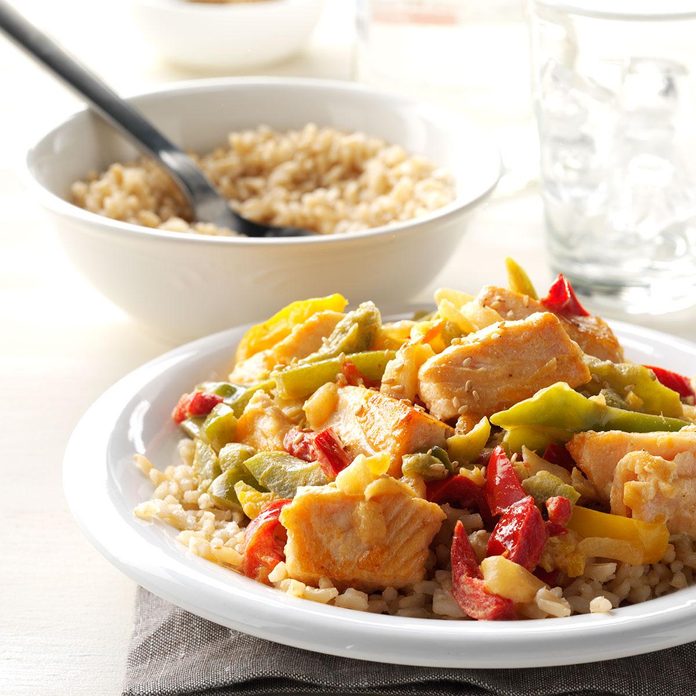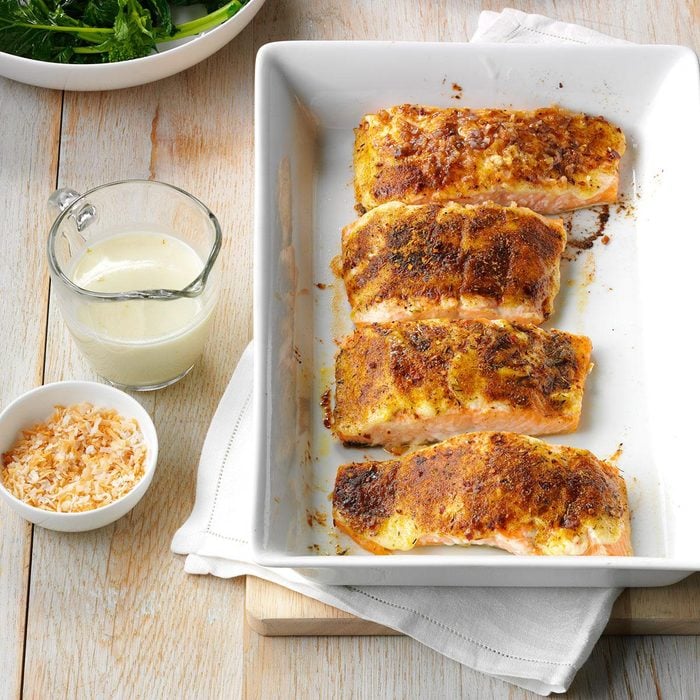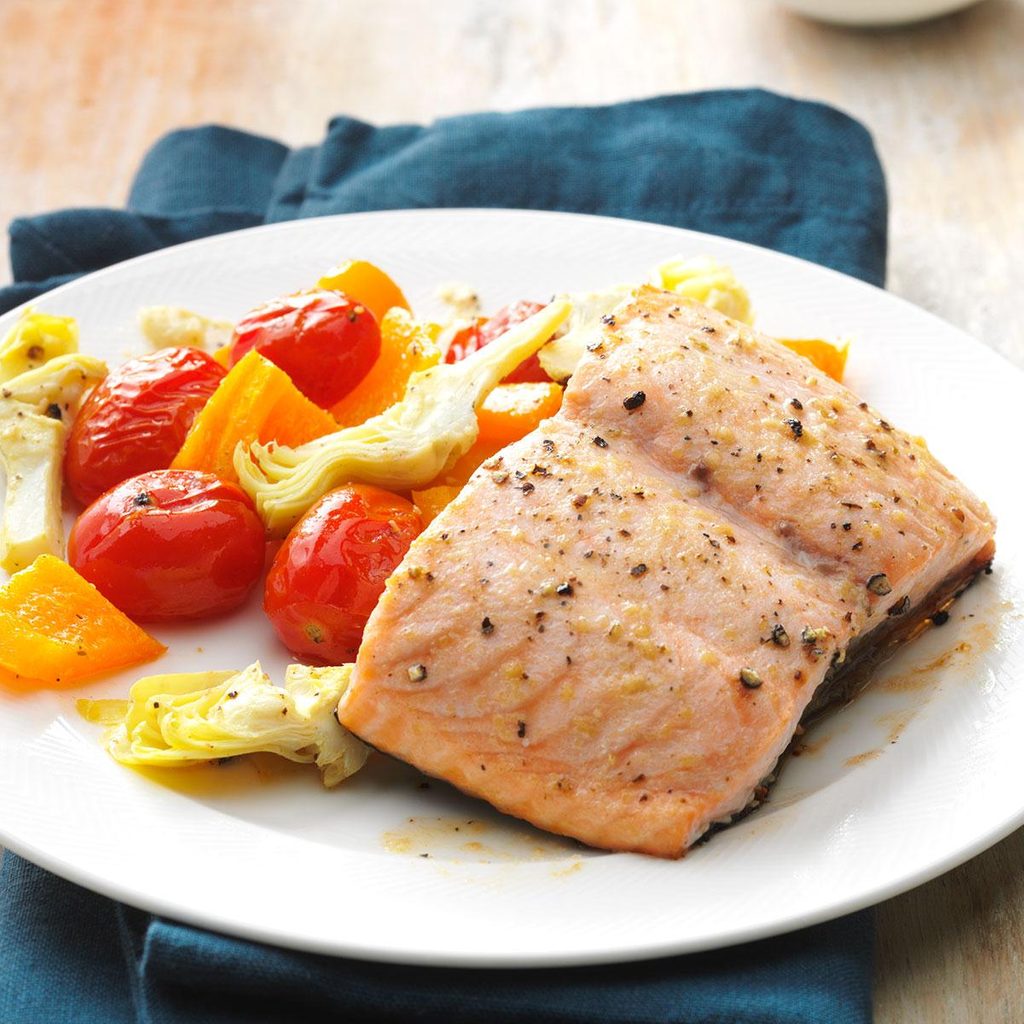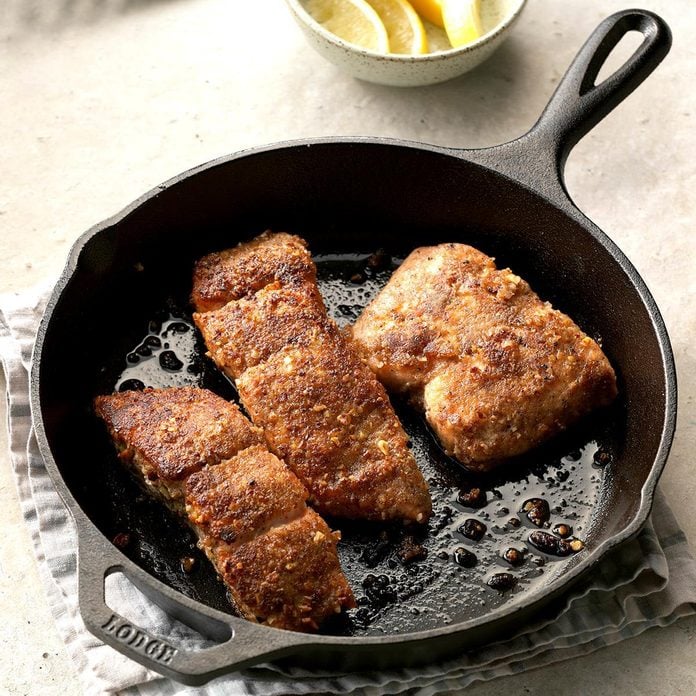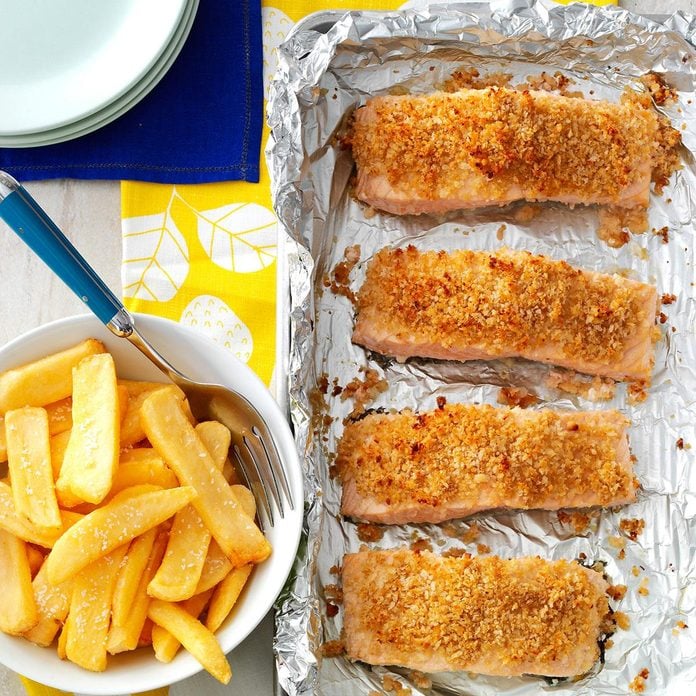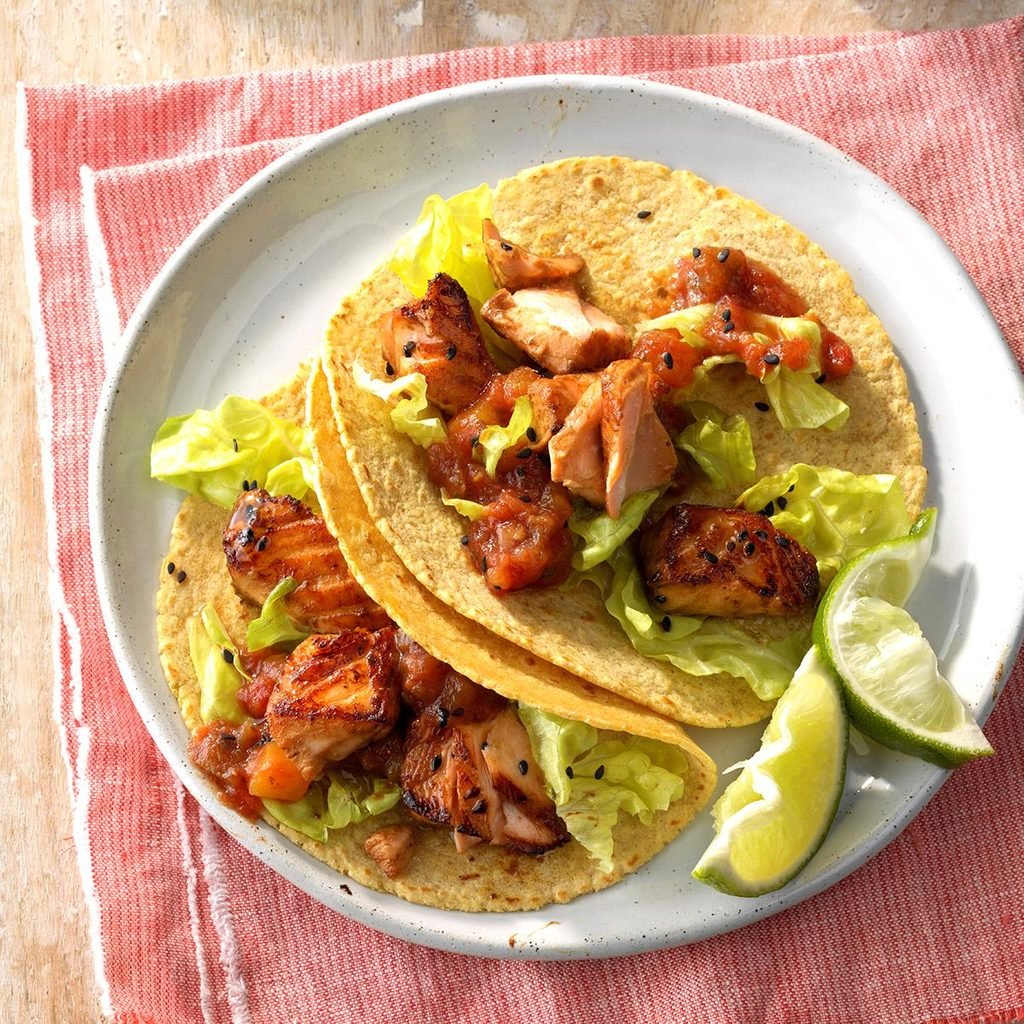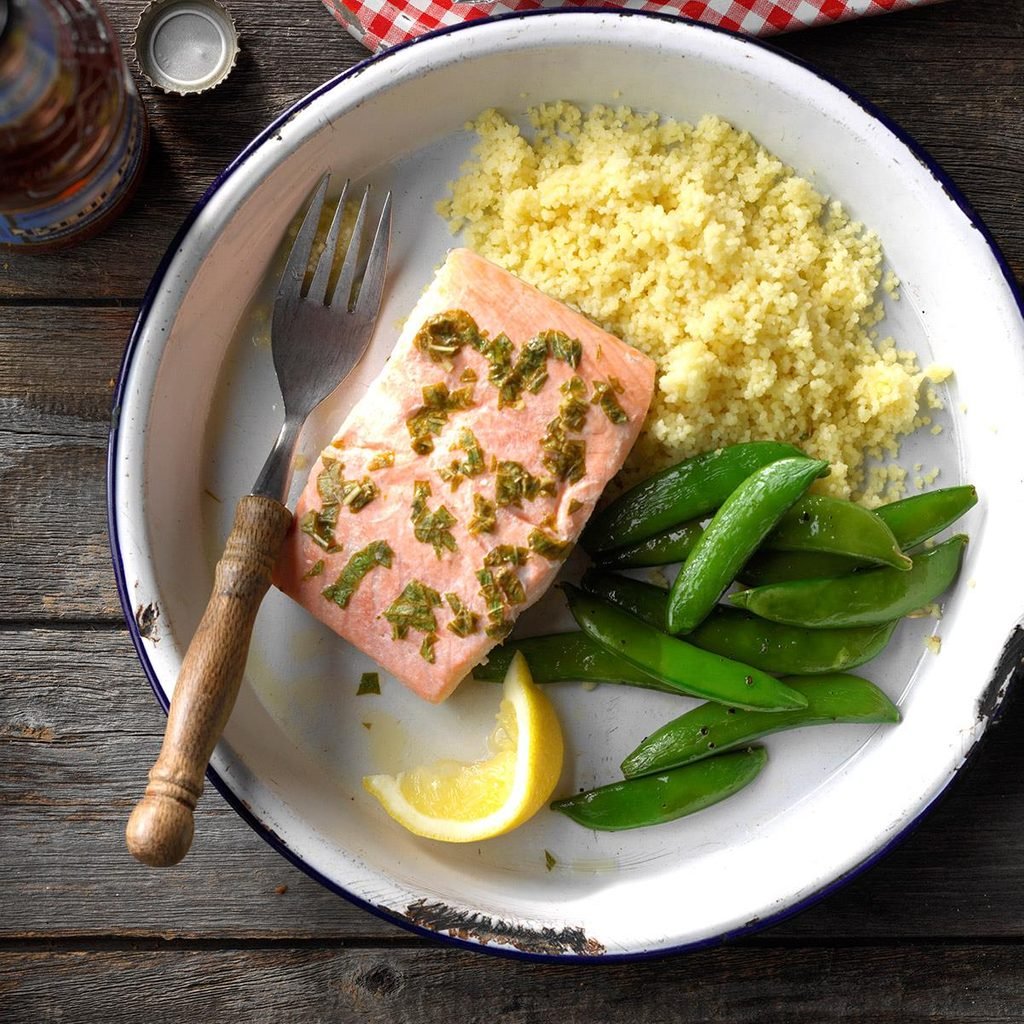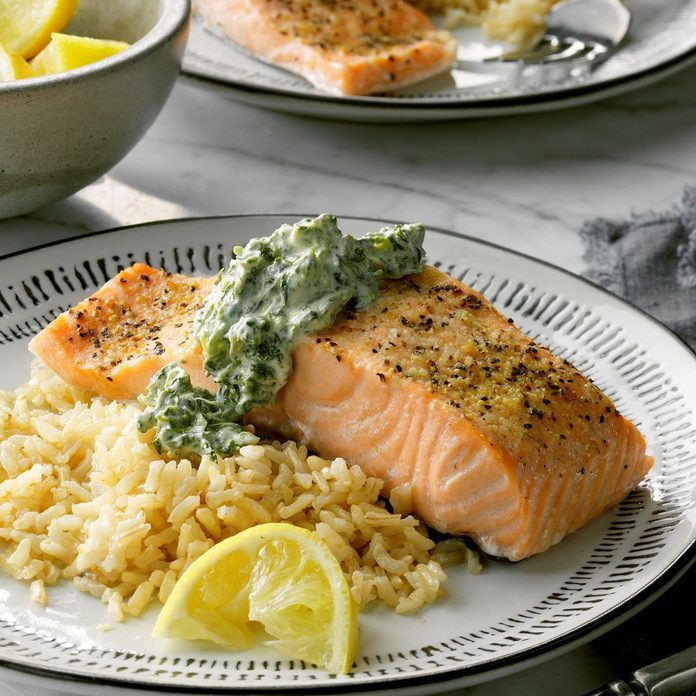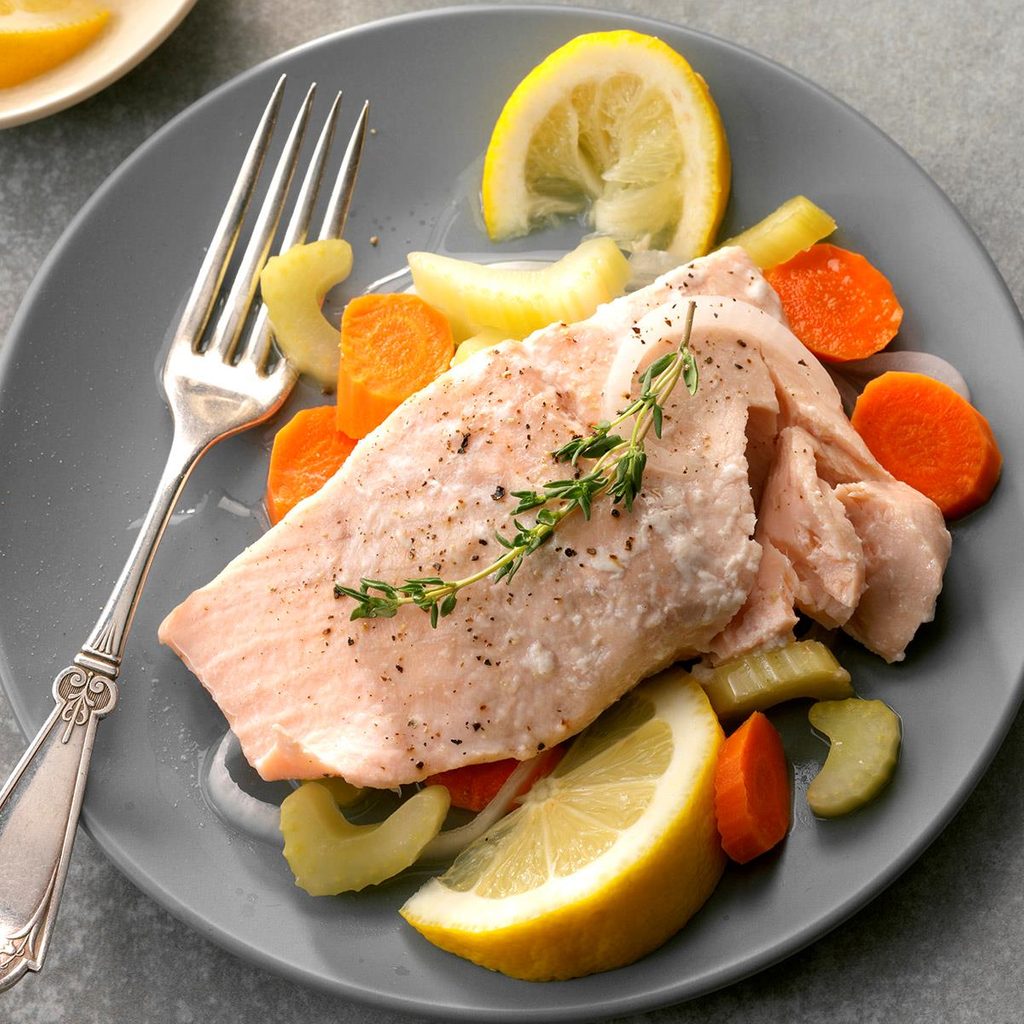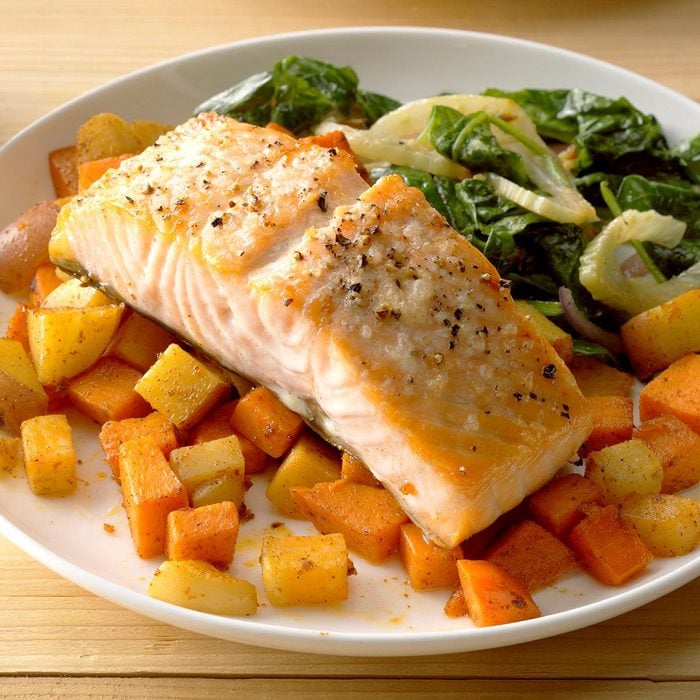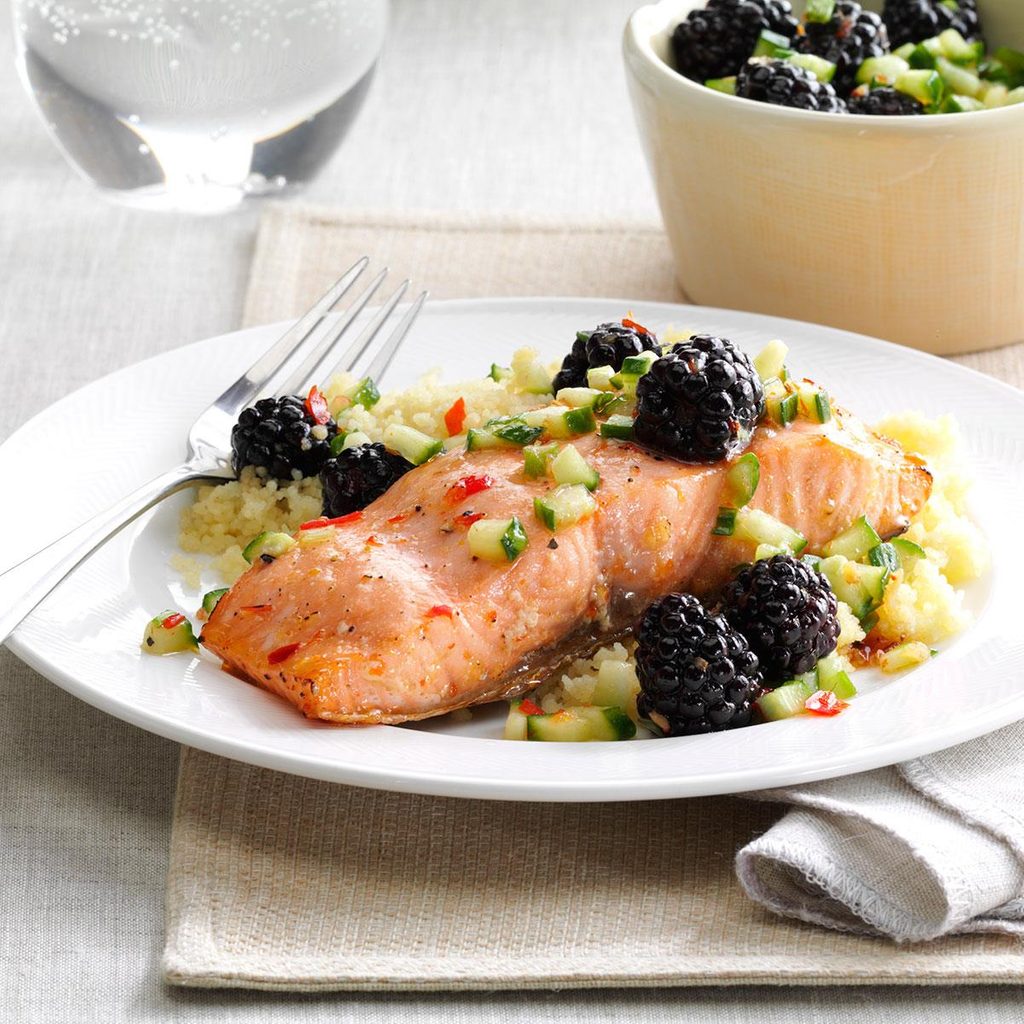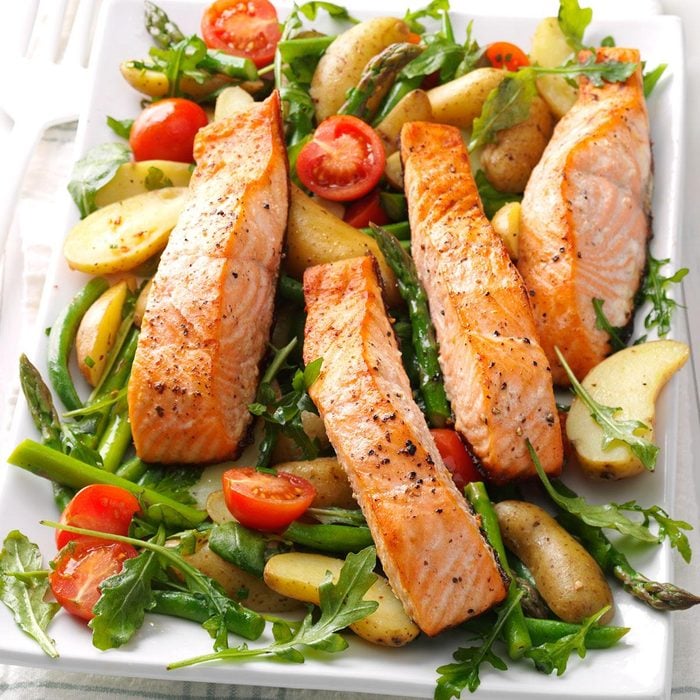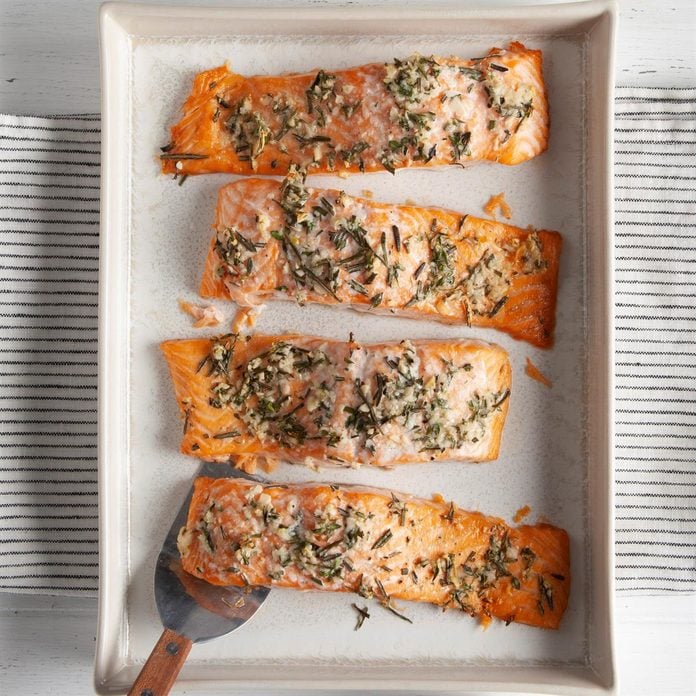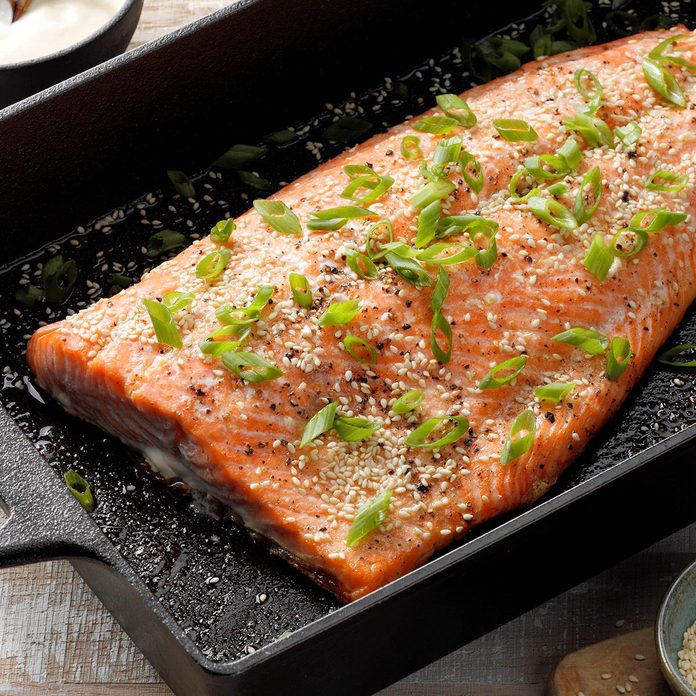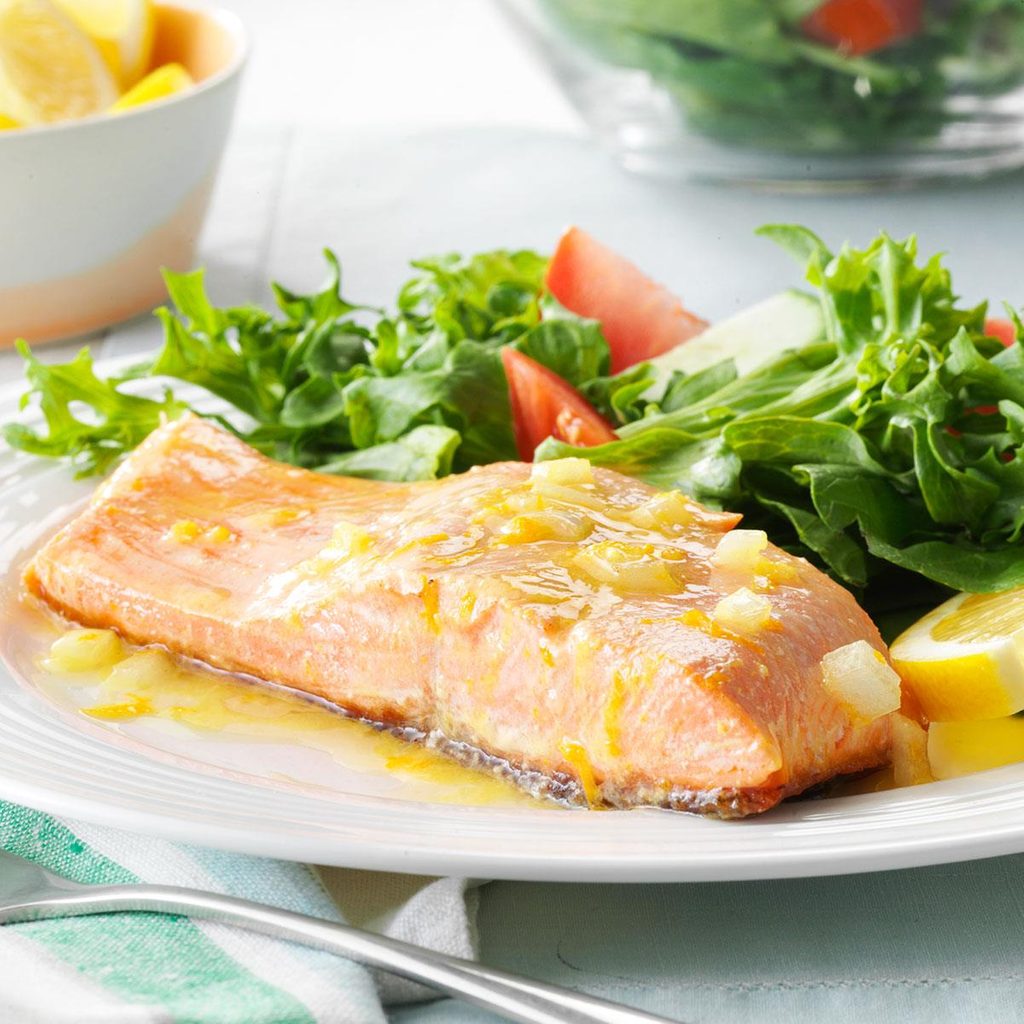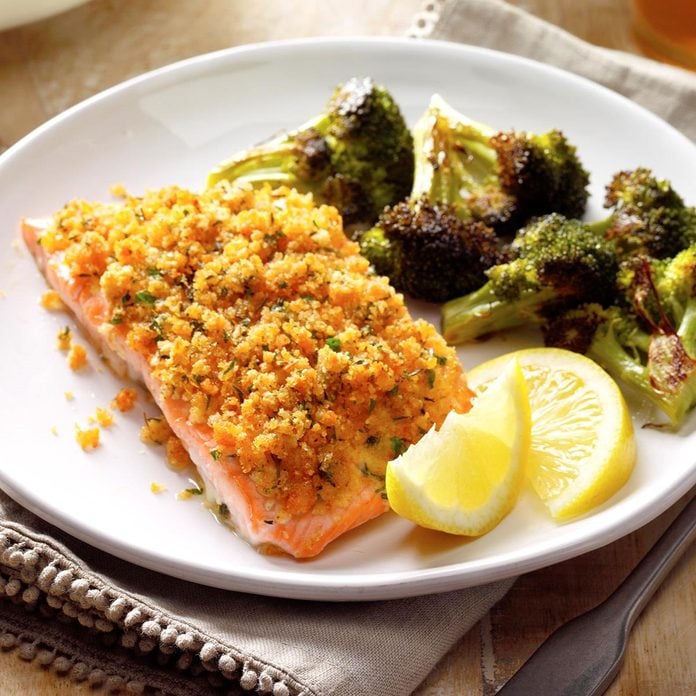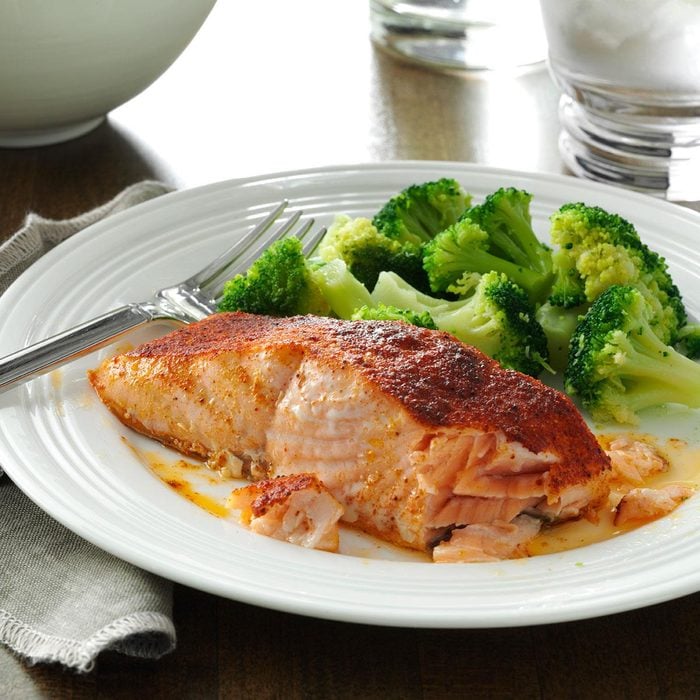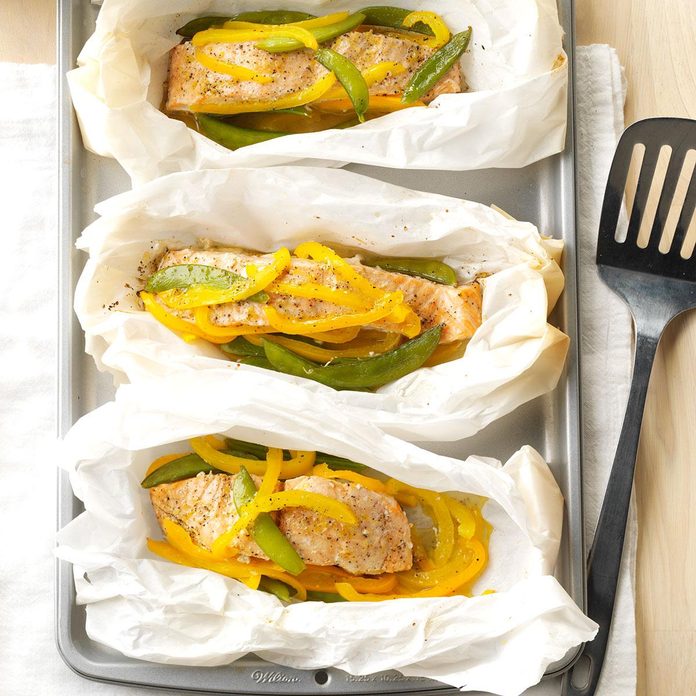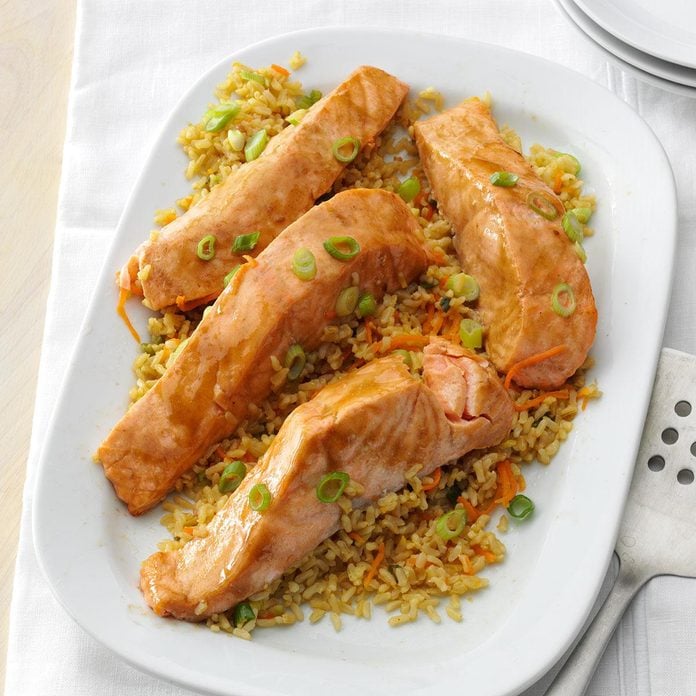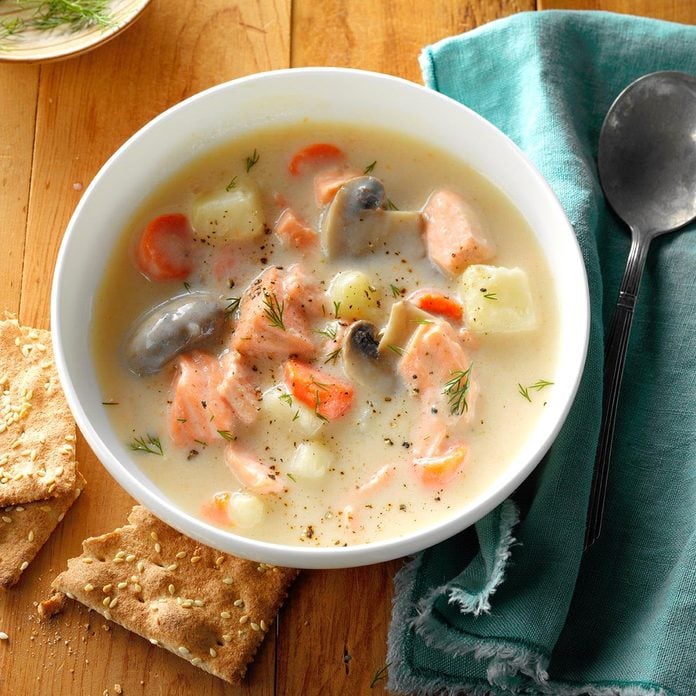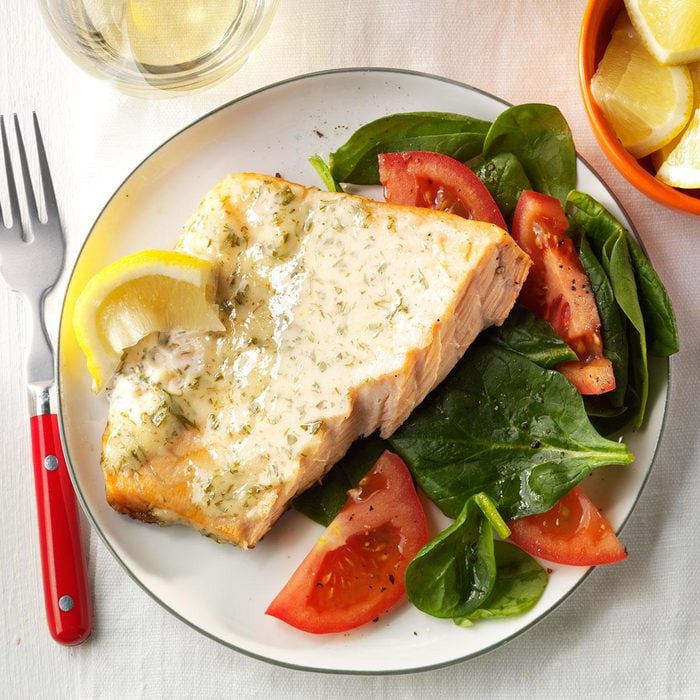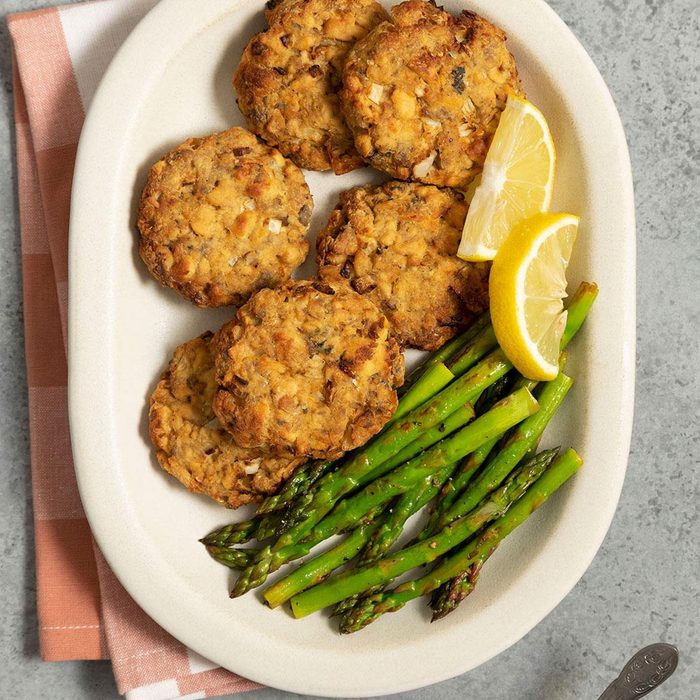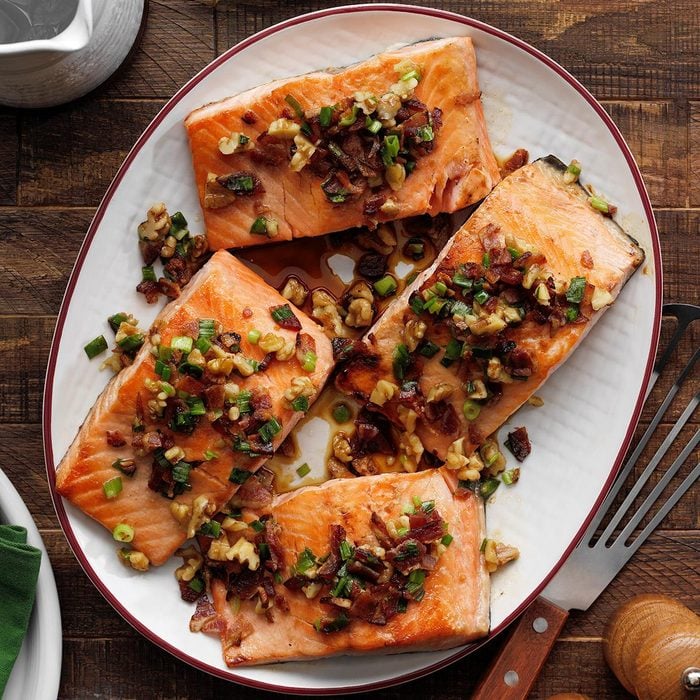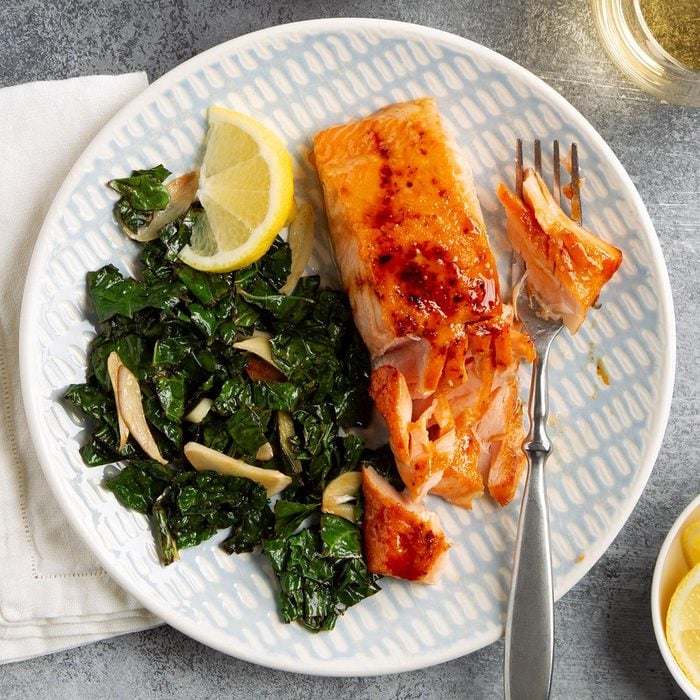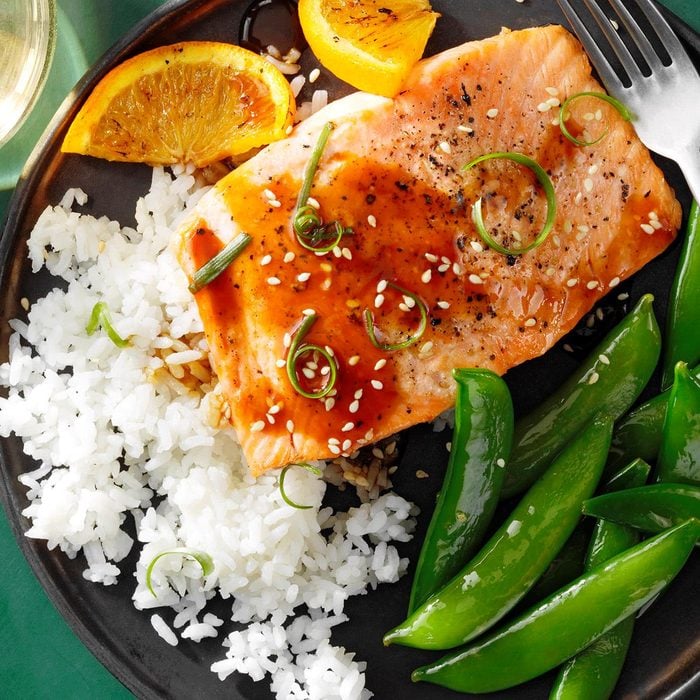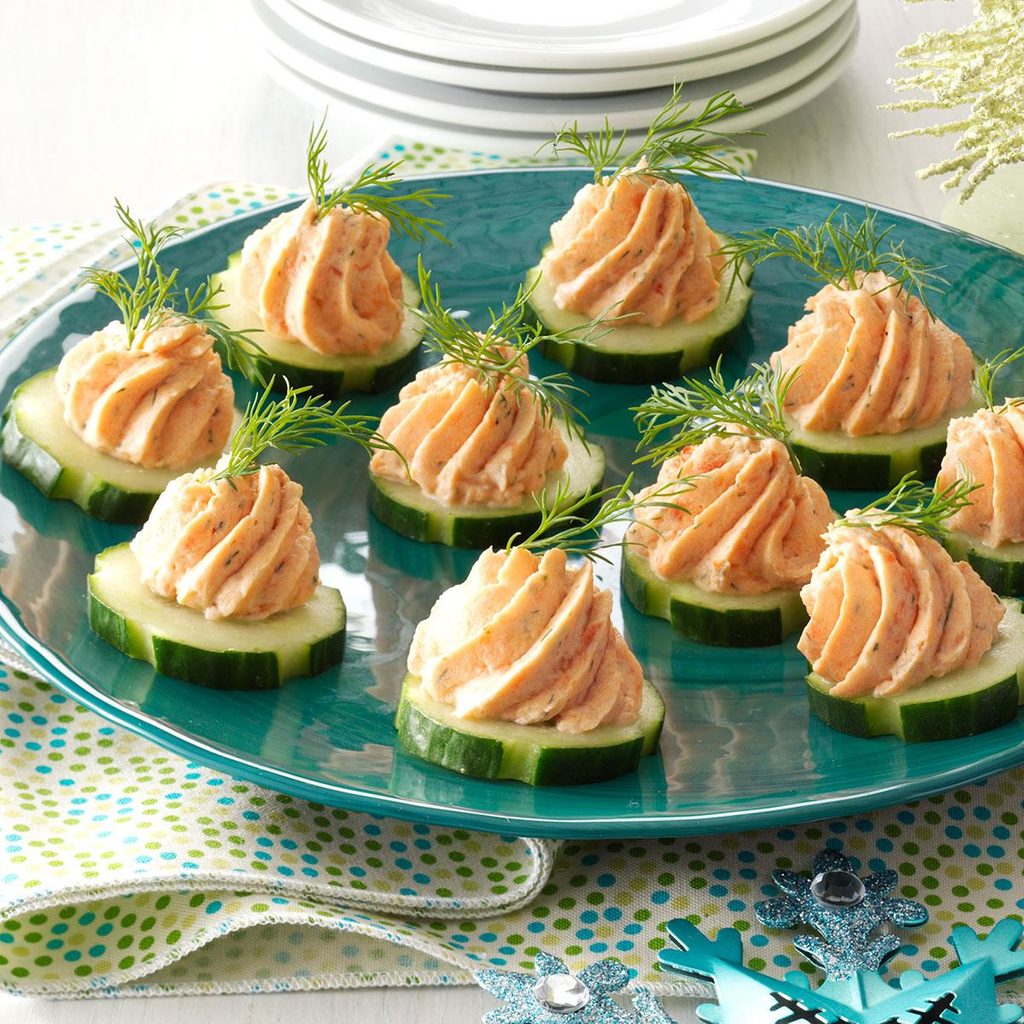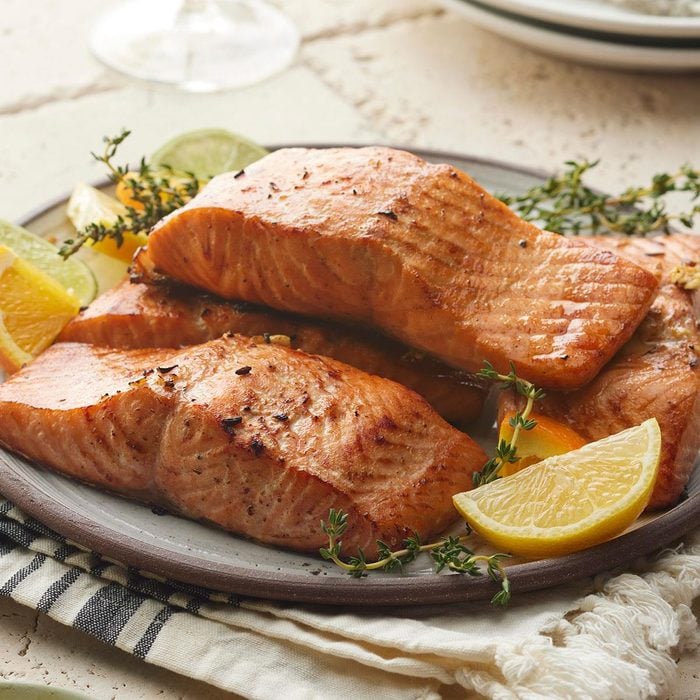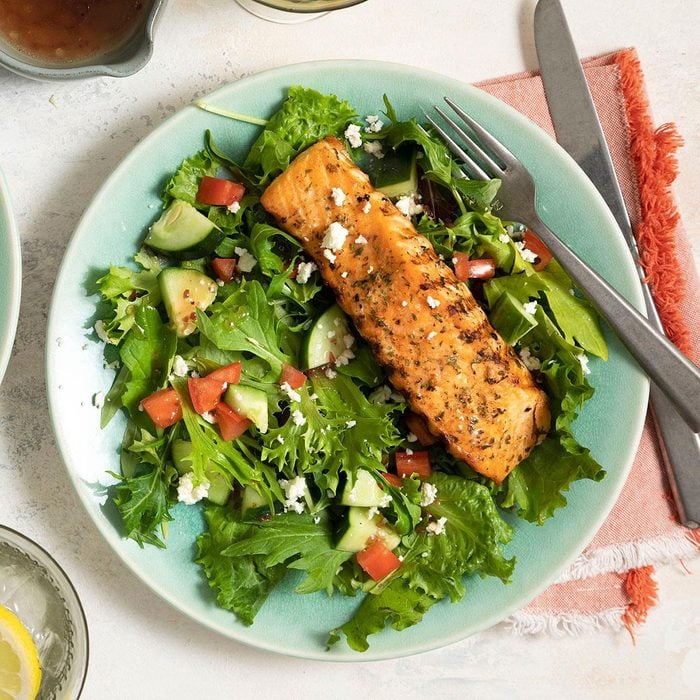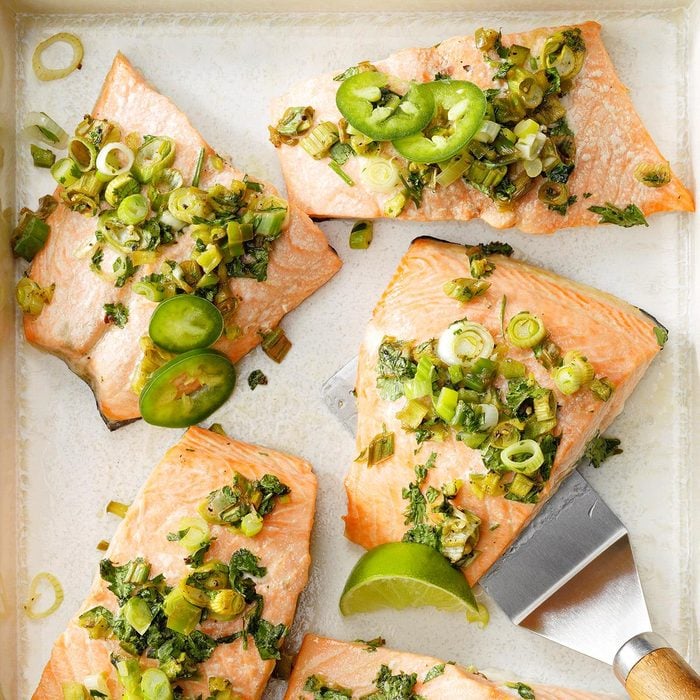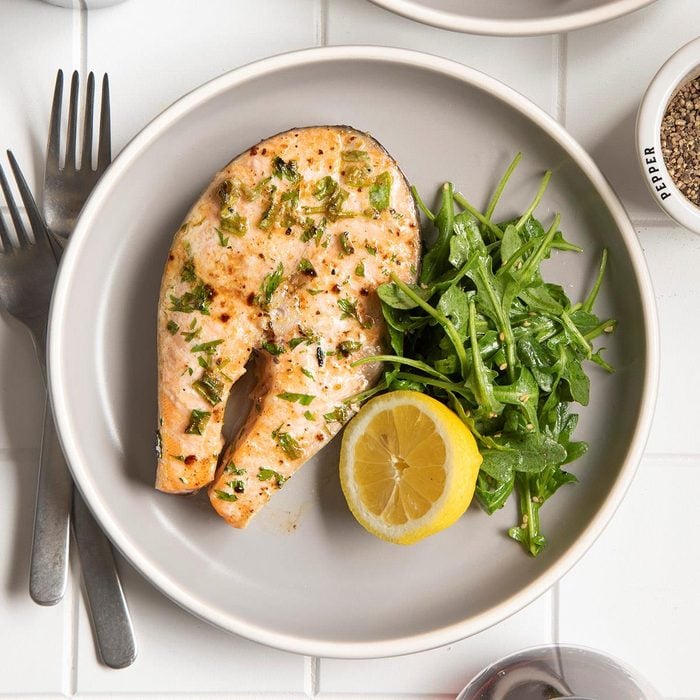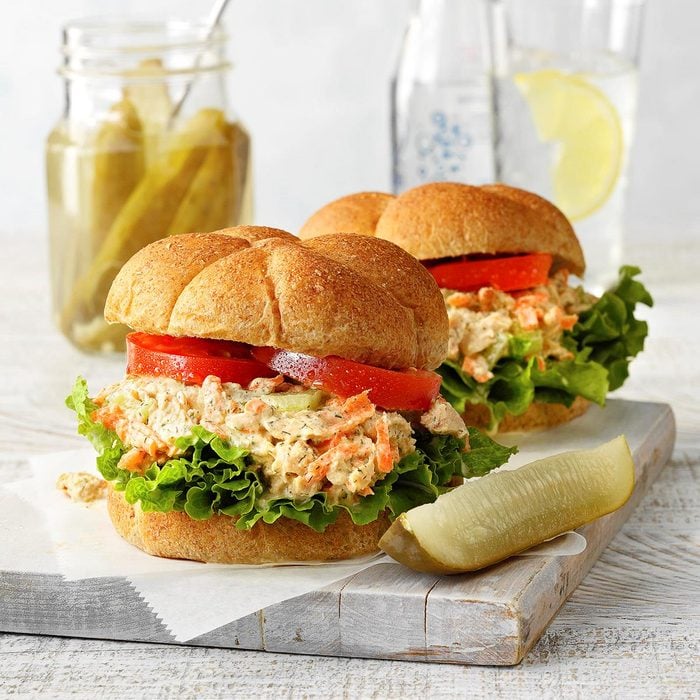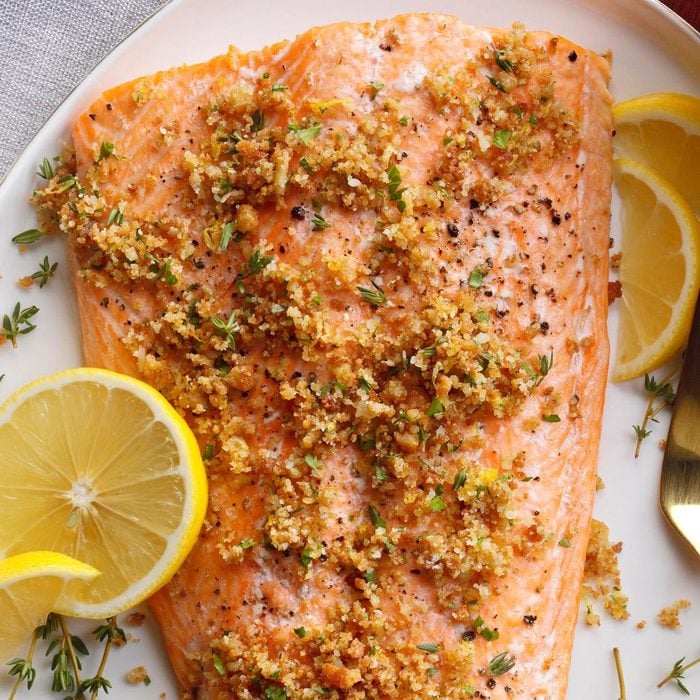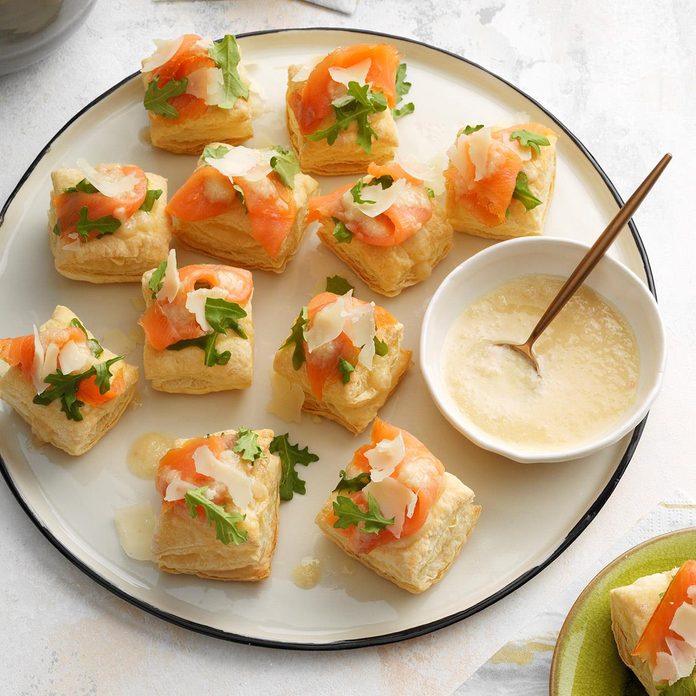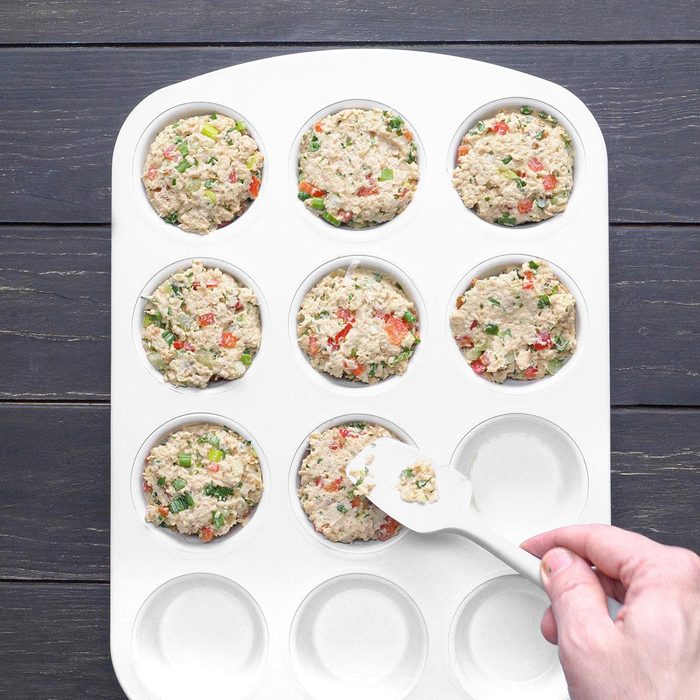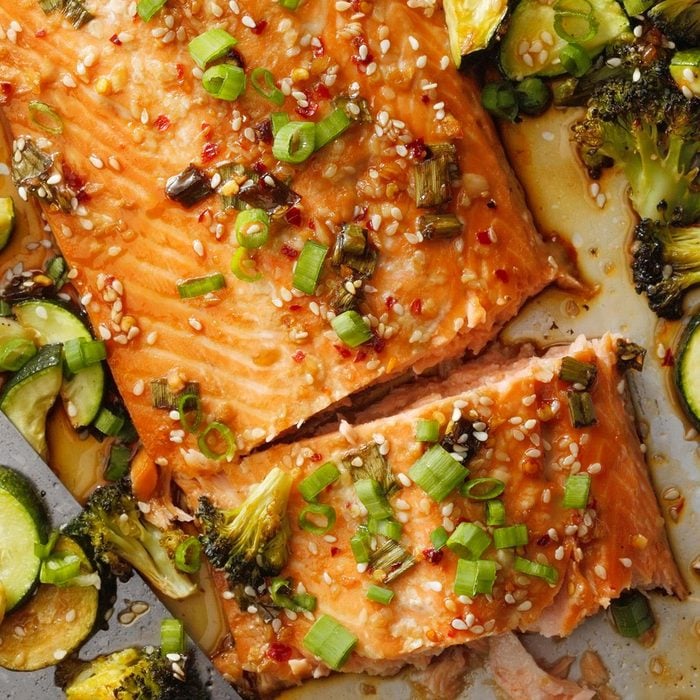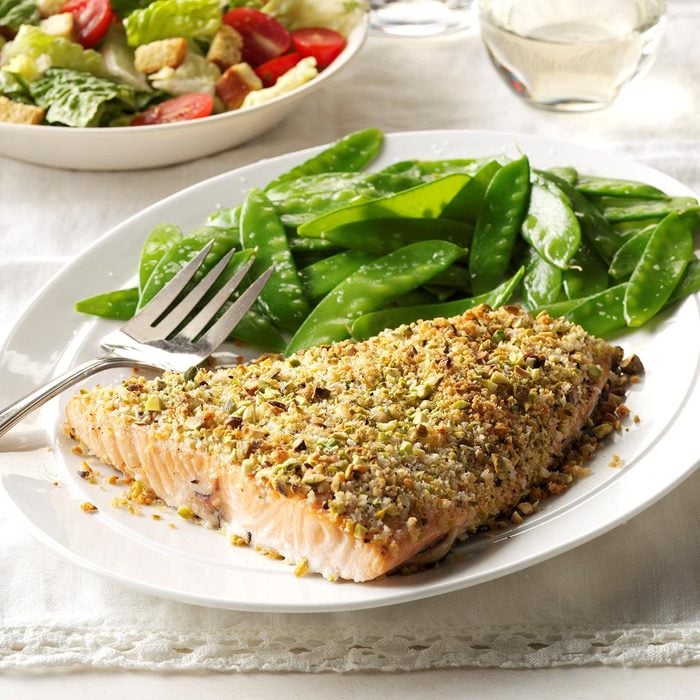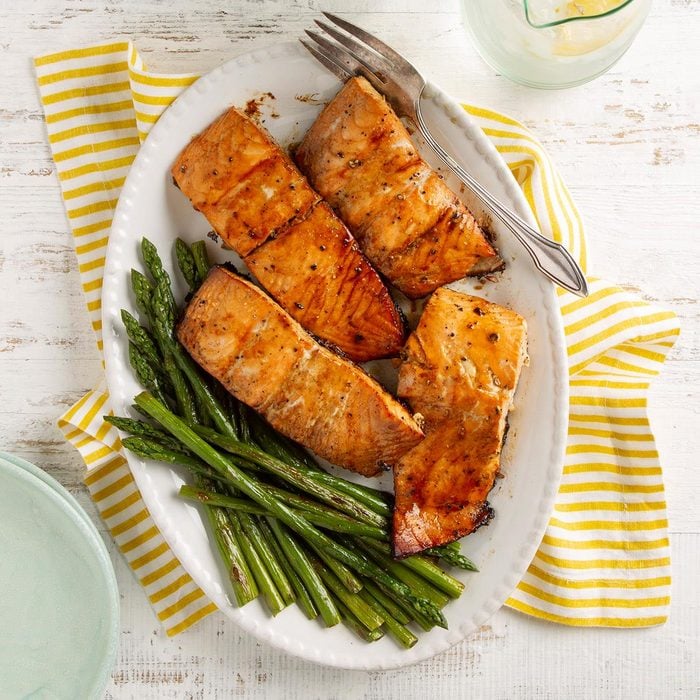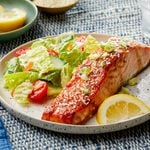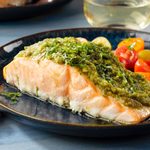If the idea of cooking fish sounds intimidating, we suggest getting started by preparing salmon. It’s generally one of the less expensive options at the fish counter, and it’s even more affordable if you buy it frozen.
That might sound like a strange suggestion—after all, chefs are always touting the quality of fresh and local ingredients. In the case of seafood, “fresh” fish doesn’t always equate to first-rate flavor. Most stores receive frozen fish that’s thawed before it goes into the fish counter, so the quality deteriorates as the day goes on. Flash-frozen salmon, on the other hand, is almost always a high-quality product, as the freezing process preserves the fish’s freshness and texture.
But doesn’t frozen salmon require long thawing times? True, salmon can take 12 to 24 hours to thaw in the refrigerator, but a little-known secret is that it’s safe to cook most fish straight from the freezer. Knowing how to cook frozen salmon is all about choosing the best cooking method, including baking, grilling and pan-searing.
Different Ways to Cook Frozen Salmon
Air-Fry Frozen Salmon
The method for making air-fried frozen salmon is almost identical to cooking a thawed salmon, with one tiny adjustment. If your go-to air-fryer salmon recipe calls for cooking the salmon at 400°F for 5 to 7 minutes a side, increase the cooking time to 7 to 9 minutes a side for frozen salmon.
Depending on the recipe, you may want to increase the air fryer’s temperature, too. In our experience, temperatures under 390°F don’t work well for frozen salmon.
Bake Frozen Salmon in the Oven
We love baked salmon recipes as weeknight dinners because they’re a hands-off way to get a delicious, healthy dinner on the table. The same can be said about baking frozen salmon, except the cooking process is divided into two steps because seasonings won’t stick to a frozen fillet.
For best results, start with a hot oven here, from 425°F to 450°F. Arrange the salmon in a single layer on a baking sheet and cook for about 5 minutes, until the top of the salmon loses its frozen sheen. Remove the sheet from the oven and add any seasonings or sauces you desire. Bake for an additional 8 to 12 minutes, depending on the size of the fillets. Are you looking for a new delicious way to bake your salmon? Learn how to bake salmon in foil.
Grill Frozen Salmon
One of the best ways to cook frozen salmon is by making a grilled salmon in foil recipe. The foil protects the frozen flesh from the grill’s harsh flames, which can burn the exterior before the inside has thawed and cooked through. It also traps the steam inside, helping the salmon thaw more evenly.
Brush the salmon with oil and season it with the seasonings of your choice before sealing the packet tightly. You can add any vegetables you desire here, too. Grill the packet over medium heat (or 375°F for pellet grills or electric smokers) for about 15 to 20 minutes. Be careful when opening the packet to check for doneness, as the steam will be very hot!
Make Frozen Salmon in a Pan
You can use any pan-seared salmon recipe to prepare frozen salmon in a pan, but we recommend rinsing the frozen salmon under cold water first and patting it dry with a paper towel before getting started. This removes any frozen ice crystals that might flake off into the pan as the fish cooks, spitting and splattering hot oil everywhere.
Heat a tablespoon or two of oil over medium heat, adding the salmon skin-side up when the oil starts to shimmer. Cook the fish for 4 to 5 minutes before flipping the fillet and seasoning the browned side. Reduce the heat to medium-low and cover the pan, trapping the steam inside. Cook for an additional 6 to 10 minutes, depending on the thickness of the salmon. Learn how to make a pan-fried salmon recipe.
Instant Pot Frozen Salmon
You have two options when it comes to cooking frozen salmon in the Instant Pot: Go the poached salmon route by cooking the fish in a flavorful liquid, or use a trivet or steamer basket insert to make steamed salmon. All you need to do differently is to increase the cooking time by two minutes. If your recipe calls for cooking the salmon for 3 minutes, adjust it to 5 minutes.
Tips for Cooking Frozen Salmon
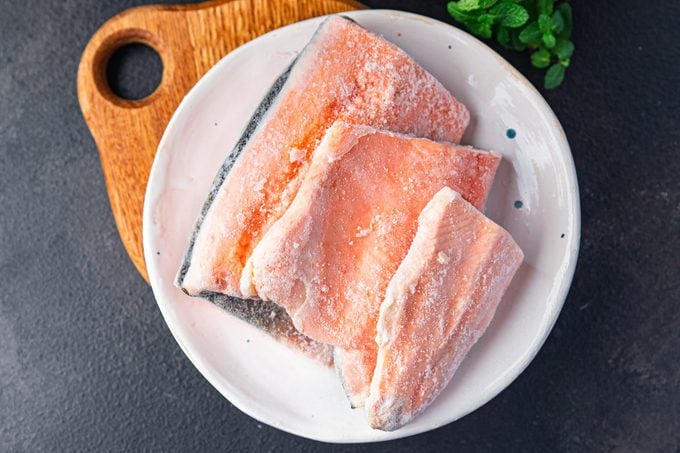 a-lesa/Getty Images
a-lesa/Getty Images
How long does it take for frozen salmon to thaw?
If you don’t want to cook your salmon from frozen, that’s okay; it’s perfectly acceptable to thaw it, first. If the fish came in vacuum-sealed packaging, remove it from the bag and place it in a bowl or a rimmed plate to catch any liquids. Let it thaw in the refrigerator overnight. Depending on the size of the fillet, it should be done in about 12 hours, but it may take up to 24 hours.
Forgot to plan ahead? We all make that mistake! You’ll still want to remove the fish from the vacuum packaging (thawing fish in this packaging can present a botulism risk) and place it in a resealable bag. Submerge the bag in a bowl of cold water, changing the water every 30 minutes until the fish is thawed. Next, try these easy salmon recipes.
What temperature should my salmon be when cooked?
While some chefs cook salmon to lower temperatures, the USDA recommends cooking fish to a safe, internal temperature of 145°F whether it’s fresh or previously frozen. You’ll know when your frozen salmon is finished cooking when the flesh flakes easily when poked with a fork and the color turns from a shiny, bright pink or red to an opaque, light pink hue.
If you see little white flecks as the salmon cooks, don’t worry. The white stuff is called albumin, a perfectly normal, safe-to-eat protein that pushes to the surface and coagulates when salmon cooks quickly at high temperatures.
Can I use marinades or seasoning on frozen salmon?
While you can season frozen salmon, we don’t generally recommend it. The seasonings don’t stick to the frozen surface, so they flake off easily. It’s better to season the fish after a few minutes of cooking when the surface thaws enough to become sticky.
Marinades for salmon are super easy to make, often utilizing ingredients you already have in the kitchen. A marinade will work with frozen fish, but keep in mind that the frozen flesh can’t absorb the flavors as readily as thawed salmon. It may result in uneven seasoning.
What can I serve with salmon?
The better question here is what can’t you serve with salmon? The best side dishes for salmon include veggies, grains and salads. Try pairing salmon with herb-roasted vegetables like potatoes, carrots, asparagus or broccoli. To make the meal more filling, add a grain like pasta, quinoa or rice.
When it comes to sauces, there are a multitude of options. Try a creamy dill sauce, a refreshing balsamic orange sauce or a rich Mornay sauce. Asian sauces like teriyaki or a soy-ginger glaze also work really well.
Up Next: 50 Easy Salmon Recipes
Grilled Salmon FilletHere's a prime example of salmon's ability to transform with strong flavors. A rich glaze of soy sauce, red wine vinegar and lemon soaks into the fish while fresh Parmesan crusts the outside.
Salmon with Creamy Dill SauceTopped with a creamy dill sauce and lightly spiked with horseradish, this top-rated salmon recipe sounds like a restaurant entree—but you can make it in a little over half an hour. This
baked salmon cooks inside a foil packet, resulting in tender fish that won't dry out (not to mention very easy clean-up).
Maple-Glazed SalmonThis quick and easy salmon recipe takes just 20 minutes from prep to serving, without stinting on flavor. The sweet and tangy sauce, made with grapefruit juice, balsamic vinegar and maple syrup, complements the rich, savory fish. Serve with a delicious
side dish for salmon.
Salmon with Vegetable SalsaSalmon fillets take just minutes to cook in a skillet. In this recipe, the fish takes a
Southwestern slant with a seasoning of lime juice and spicy cayenne pepper. Serve with a quick, fresh salsa that brightens the richness of the fish.
Rosemary Salmon and VeggiesA perk of roasting salmon for dinner? Cooking your vegetable side dish in the same pan! In this recipe, salmon fillet shares seasonings with asparagus and peppers, but chopped cauliflower, sliced zucchini or fresh green beans are delicious alternatives.
Sage-Rubbed SalmonStarting the fish on a cast iron skillet sears the skin, and finishing in the oven results in tender fish. This herb-rubbed salmon recipe takes less than 20 minutes, start to finish! If you're not partial to sage, replace it with another herb, such as rosemary, basil or dill.
Foil-Baked SalmonYou can cook the foil packets in the oven or on the grill, and switch up the seasonings whenever you make it—the super-quick salmon recipe is a template for all kinds of meals. All kinds of citrus, herbs and spices taste great with salmon. Think garlic and butter, rosemary and lemon or a curry spice mix.
Salmon with Horseradish Pistachio CrustLevel up your weeknight cooking with this crispy, crunchy crust of breadcrumbs and chopped nuts. Use pistachios or whichever nut you like (pecans and walnuts are especially good). While the salmon bakes, whip up a
quick side dish.
Potato Cheese Soup with SalmonNot every salmon dinner needs to be made with a whole fillet. Try this cozy, comforting soup, made with potatoes, milk and cheddar cheese. Use canned salmon or leftover cooked salmon, flaked with a fork.
Salmon with Spinach & White BeansGarlicky greens and beans are a delicious complement to broiled salmon. Since the salmon is lightly seasoned, be sure to buy the freshest fillet you can. Here's
how to shop for salmon.
Balsamic-Salmon Spinach SaladNeed a
healthy, quick dinner? This salad comes together in about 20 minutes. Broiled salmon cooks in about the time it takes to mix a vinaigrette. Add just about any veggies, nuts, seeds or dried fruits you like.
Garlic Salmon LinguineDelicious salmon linguine tastes bright and fresh, but it's made with ingredients you can find in your pantry.
Canned salmon is a useful staple to keep on hand, but you can also use leftover cooked salmon too if you have it.
Cajun Boil on the GrillThese spicy salmon packets serve up a complete meal, including perfectly seasoned salmon, shrimp and vegetable sides. The best part? Since each packet serves one, it's easy to scale the recipe up to serve a big party. They taste great with
summer potluck sides.
Garlic Lime SalmonCitrus tastes great with salmon: the zesty, acidic fruits brighten and balance the savory richness of the fish. Here, lime and garlic make a simple, flavorful seasoning. Plate this fish with salad, rice and vegetables.
Garlic & Herb Artichoke SalmonIf you love
artichokes, bookmark this recipe! While it looks fancy, the dinner comes together quickly thanks to canned artichoke hearts and store-bought cheese spread.
Salmon Grilled in FoilFiring up the grill? Grilled fish cooks super quick. This recipe is ready in under 20 minutes! The fish is ready when it flakes easily with a fork. See lots of white stuff on top of the fish? It may be overcooked—keep a closer eye next time.
Speedy Salmon Stir-FryOnce you learn
how to make a simple stir-fry, you can adapt the technique to just about any fish, poultry, meat and vegetable combination you can dream up. This salmon stir-fry calls for a bag of frozen vegetables for convenience, but you can use any fresh vegetables you like.
Jamaican Salmon with Coconut Cream SauceSome of our favorite dinners are made in our trusty
13x9 pan. They're quick to prep, simple to bake and clean up quick. This simple salmon dinner has a Jamaican touch thanks to a sweet-and-sour seasoning made with sour cream, coconut and lime.
Caesar Salmon with Roasted Tomatoes & ArtichokesThis five-ingredient salmon dinner channels the best flavors of a Caesar salad. The fish bakes alongside a tomato, pepper and artichoke salad, making it an effortless
sheet-pan dinner.
Crusted SalmonFancy dinners don't have to be fussy! This salmon dinner is a prime example; simply coat salmon fillets in a sweet-and-savory crust and bake. They'll be ready in 10 minutes. Serve with a salad or
vegetable side.
Crispy Fish & ChipsMake the British takeout favorite in your home kitchen—this
copycat recipe takes just 30 minutes to make. Since the fish is baked instead of fried, you get all the crispy coating without the heavy fat.
Asian Salmon TacosThis quick salmon recipe is the ultimate fusion food: Asian-spiced salmon served taco-style in tortillas. It's a simple twist on
Taco Tuesday.
Lemon Basil SalmonFresh, flavorful lemon basil salmon cooks up tenderly in a foil packet. You can make this recipe on a gas or charcoal grill, or even turn it into a
campfire recipe.
These
top-rated salmon recipes are a sure thing for dinner.
Salmon with Spinach SauceYour
Instant Pot, can make for a very fast cooking method for salmon. Poaching salmon preserves moisture, resulting in a delicate and tender fish every time. Serve with crusty bread and a fresh salad.
Slow-Cooker SalmonSalmon cooks so quickly, it seems impossible to cook in a slow cooker, but the gentle, low heat is a great match for succulent salmon. This recipe is ideal for a large piece of salmon—cook the whole filet and slice before serving. Don't remove the skin; that's a
common mistake when cooking fish.
Salmon with Root VegetablesRoot vegetables are notorious for taking a long time to cook, so here's a handy trick: dicing them into bite-sized pieces means they'll cook in about 20 minutes. This
healthy one-pan recipe calls for a mix of root vegetables, but you can use whichever ones you like.
Sweet-Chili Salmon with BlackberriesSalmon and blackberries might sound like a strange combination, but berries taste great in
savory dishes. This sweet, spicy salmon recipe is sure to break you out of a cooking rut.
Salmon and Spud SaladSmart cooks take advantage of kitchen shortcuts like cooking all your vegetables in a single pot of water. Add the vegetables in order of longest to shortest cooking times. This healthy salmon recipe is easy to adjust to your season or your tastes; swap out whichever veggies you have on hand.
Herb-Roasted Salmon FilletsRosemary and thyme are a classic flavor combination, and one that pairs well with this roasted salmon dinner recipe, which comes together in 30 minutes. Serve alongside an easy steamed veggie, like asparagus or green beans.
Sesame Salmon with Wasabi MayoLove
spicy food? This salmon has a bit of a bite thanks to the wasabi mayo. The lemon juice will cut some of the heat from the wasabi and enliven this otherwise simple dish.
Grilled Citrus SalmonLemon and oranges brighten up this yummy grilled salmon. If your fish has any whiff of fishiness before cooking, soak it in milk for half an hour or so, which will neutralize that flavor. Discard the milk, cook as usual, and the citrus will really shine through.
Crumb-Topped SalmonThis salmon dinner has all the markings of a fish-and-chips takeout: a crispy, buttery crust, flaky fish and bright lemon flavor. The difference? Heart-healthy salmon is baked, not deep-fried. It's a
lighter take on comfort food.
Oven-Barbecued SalmonCrave barbecue but don't want to fire up the grill? Try this
baked salmon. Adjust the simple homemade barbecue sauce to suit your spice tolerance, or make it even quicker by using bottled sauce. (These are our favorite
store-bought barbecue sauces.)
Salmon Veggie PacketsFrench food has a reputation for fussiness, but many French techniques are simple to master and guarantee delicious results. Baking salmon en papillote (in parchment) allows salmon to cook gently, protected from direct heat, sealing in moisture and flavor. Dinner is so simple, you'll have plenty of time to prepare a
French dessert to serve afterward.
Ginger Salmon with Brown RiceThis fast salmon recipe calls for just five ingredients. Store-bought salad dressing does double duty as both glaze for the salmon and sauce for the one-pan rice side dish.
Weeknight dinner has never been easier.
Salmon Dill SoupNeed a cozy dinner on a chilly night? Try this salmon soup, with its creamy, rich blend of potatoes, mushrooms and salmon. A sprinkle of dill brightens up the hearty bowl, but you could also use parsley or cilantro.
Mesquite SalmonIf you love smoked salmon, don't miss out on this mesquite-flavored grilled salmon. A sweet, yet tart, dipping sauce balances the smoky fish. Don't throw out the leftover sauce! You can use it as a sandwich spread.
Air-Fryer Salmon PattiesThe air fryer makes crispy, savory salmon patties in a jiffy. This recipe uses a nice shortcut: saltine crackers in the crust, which are easy to crumble and already salted.
Maple Bourbon SalmonRich maple syrup, bourbon and walnuts make this salmon recipe the perfect fall dinner. Serve with your favorite
fall side dish and open a cozy wine to sip on while you enjoy this sweet salmon.
Honey-Mustard Glazed SalmonA quick sauce of mustard, brown sugar and honey takes seconds to stir together, but infuses salmon fillets with abundant flavor. This recipe calls for 10 fillets, making it ideal for dinner parties, but you can scale down to suit your needs. Leftover salmon keeps well in the fridge for a few days; use it in soups, casseroles or to top salads.
Orange Soy Salmon with RiceA sweet and tangy Asian-inspired sauce makes this salmon recipe pop. Best of all, it's ready in just 20 minutes. Steamed broccoli makes a speedy side dish to match.
Salmon Mousse CanapesNeed a fast appetizer? Try this simple salmon mousse, made with smoked salmon and cream cheese. Serve on cucumber slices or as a dip alongside crackers and
crudité.
Citrus-Marinated SalmonDelicate fish is quick to absorb the flavor of a marinade: you can set this one up just 30 minutes before cooking. Orange, lemon and lime juice pack big citrus flavor, while earthy herbs ground the brightness. Serve with a
grilled side dish.
Feta Salmon SaladInspired by the flavors of perennially popular Greek salad, this salad is delightful at lunch or dinner. Feel free to add additional vegetables to the salad, as well as toppers like seeds, toasted nuts or chickpeas.
Cilantro-Topped SalmonFor an unexpected twist on salmon, try this Southwestern-inspired dish. The zesty lime, jalapeno and cilantro sauce tastes great with plain rice, or serve the salmon on tortillas a lá fish tacos.
Special Salmon SteaksWith a French-inspired sauce of butter, lemon and parsley, this salmon tastes indulgent and special, but it's simple enough to make any night of the week. Serve with a salad, or lean into the decadence with
mashed potatoes.
Salmon Salad SandwichesHave leftover cooked salmon in the fridge? Whip up these tasty sandwiches! Shredding carrots into the mix adds both crunch and sweetness. You can also use canned salmon.
Lemon Herbed SalmonTossing breadcrumbs with herbs, lemon zest and Parmesan cheese lends an instant update to plain breading. This mixture tastes delicious on salmon, as well as chicken and pork.
Smoked Salmon Bites with Shallot SauceThese bite-sized pastries look fancy enough for a high
tea party, but they come together in half an hour! Use frozen puff pastry for a flaky base, stir together a zippy sauce and top with smoked salmon.
Baked Salmon PattiesLove salmon patties but trying to cut down on fat? Try these baked salmon cakes. The trick for the perfectly round shape? Cook the salmon in muffin tins to hold the shape.
Sheet-Pan Soy-Ginger Salmon with VeggiesIt takes about 20 minutes to set up this all-in-one sheet pan supper, and then you just slide it into the oven and let it roast! A delicious ginger-soy sauce infuses the fish and vegetables with plenty of flavor.
Pistachio SalmonThis recipe relies on a classic breading mixture to add flavor and crunch to salmon fillets. The simple salmon is delicious served over a fresh salad, alongside steamed vegetables or even on top of rolls.
Bourbon-Glazed SalmonAdding bourbon in a salmon glaze provides both sweetness and a lovely caramelized coating to the fish. This recipe looks fancy, but it's ready in
less than 30 minutes.
